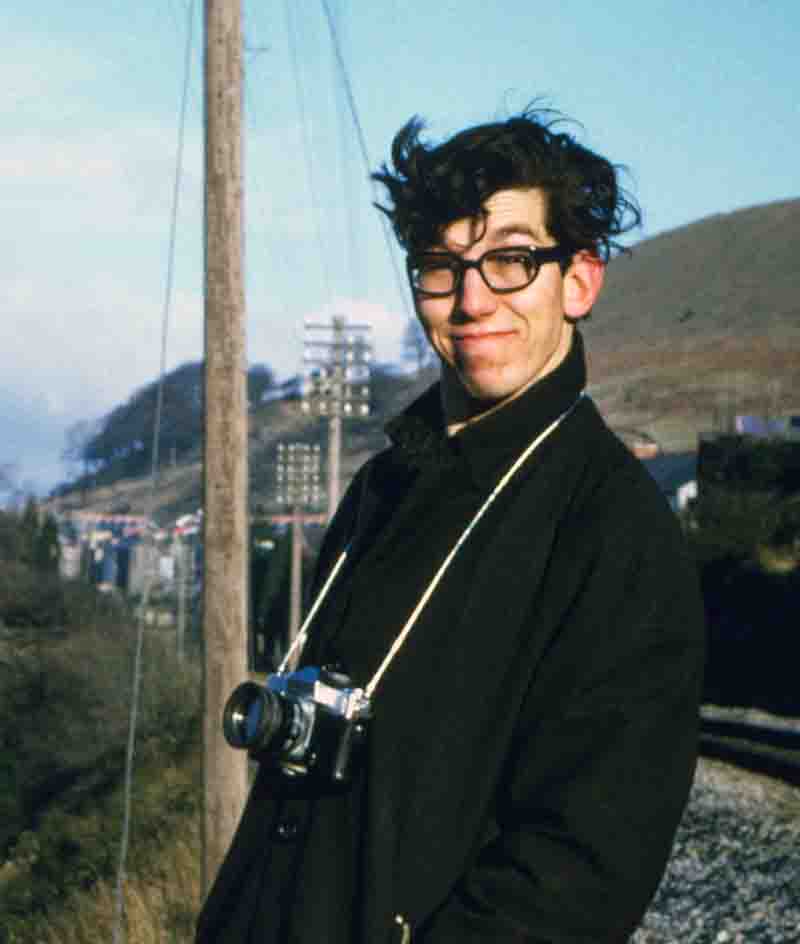There follows reproduction of Mikes autobiographical notes published in "NEVER AGAIN -
Vol. 4" illustrated with his own pictures (except where otherwise noted).
"It was inevitable
that I would develop an interest in steam. One grandfather and three uncles were Great Western
drivers and my earliest clear memory is being taken to Stratford shed by my grandfather. From where
I lived in Stratford, I could hear the sound of freight trains, accompanied by the distinctive "clank"
of the WDs struggling up the bank to Goldicote on the former Stratford and Midland Junction Railway line,
mixed up with the roar of a Vickers Valiant lifting off from RAF Gaydon with its lethal
hydrogen bomb load.
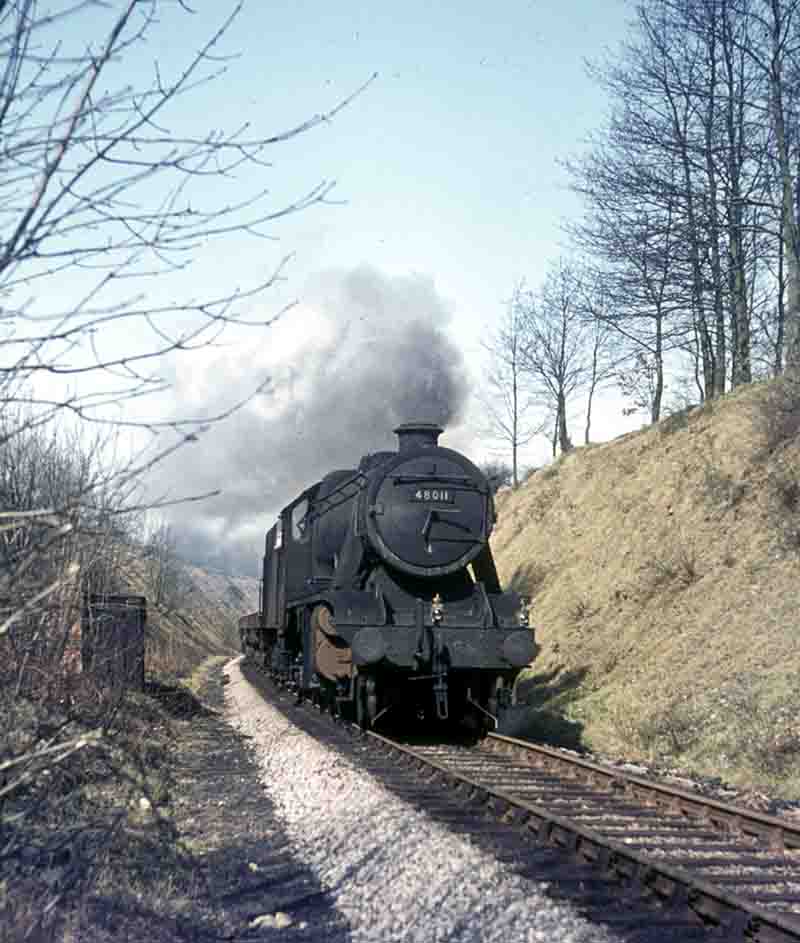
Not a WD! - Ex LMSR class 8F 2-8-0 number 48011 heads an eastbound freight up Goldicote cutting on the climb from Stratford towards Kineton on 18/4/1964.
My grandparents and an aunt lived at the other end of town within yards of the Great Western line to the South West. On the way there we nearly always had to wait by the level crossing at Evesham Road and the sight and the smell of a steam hauled train.
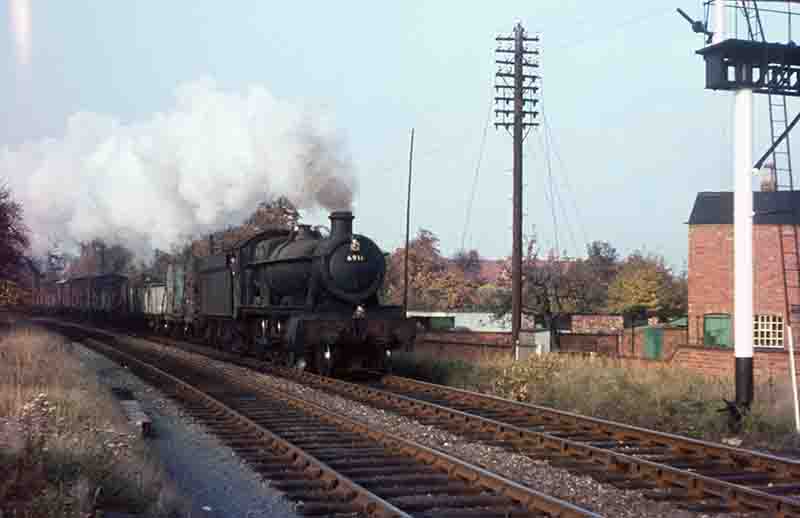
Ex GWR Hall class 4-6-0 number 6911 "Holker Hall" heads a down freight approaching Evesham Road Crossing on 28/9/1964.
When I was a bit older, in the nineteen fifties, when it was still safe for young children to
wander at will on bikes, my friends and I would find a railway line and watch trains. The
discovery of Ian Allan ABCs set me on the road to trainspotting. Favourite spots were around
Stratford and especially summer Saturdays with trains queuing to be banked to Wilmcote. This was
usually the only chance to "cop" Penzance Granges, with their unique oily cleaning job (a preview
of the cleaning efforts of the MNA at the end of steam?).
My dad had a peripheral interest in
railways - more than that he was wine and spirits manager at Flower and Sons Brewery. Steam and beer
- a perfect grounding for a future gricer! His deputy was the late Tom Williams who used to let me
have some of his black and white prints. But he also did colour and gave improvised slide shows in
my dads office. It was his master shot of "Bath Abbey" climbing out of Chipping Campden Tunnel which
inspired me to take up railway photography. My school had an active railway society with coach trips
to Swindon Works and other seemingly far-flung places. The final inevitability had come to fruition
- I was hooked.
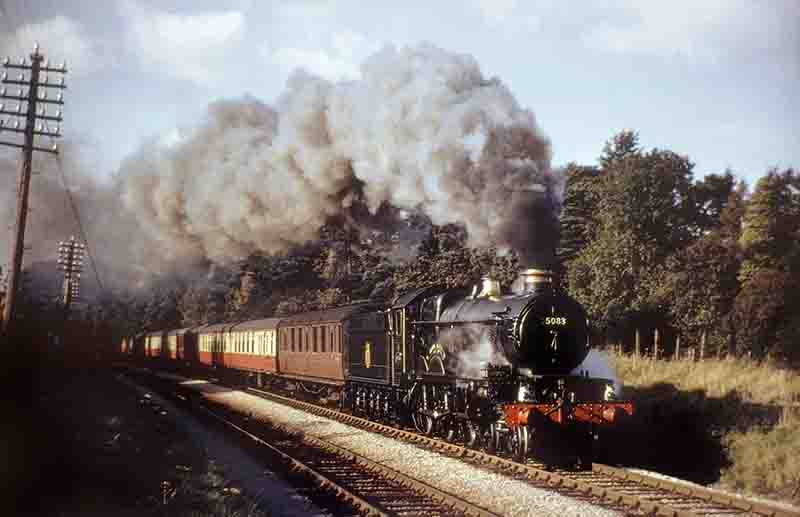
Ex GWR Castle class 4-6-0 number 5083 "Bath Abbey" heads a Worcester to Paddington express climbing the bank towards Campden tunnel in the 1950s. Photo Tom Williams.
For those very early trips, my photography was reliant on a Brownie 127, a birthday present at the age of thirteen. Tom taught me how to process the negatives - but only doing contact prints, the quality did not rival his - I wonder why? My next camera had to wait until I was fifteen - an Ensign Selfix 16-20 bellows camera, which took 16 on a 120 film. Immediately the quality improved, but money was very scarce and badly judged purchases of cheap films meant that they often were not very good, but despite this there are a few surviving gems. Eventually the camera developed holes in the bellows and the shutter and focussing became somewhat variable so it was consigned to the scrap heap to be replaced by a 35mm Zeiss Werra, acquired from Tom Williams. Fitted with a superb lems and the benefit of 1/300th of a second shutter speed, there was no excuse for failures any more. The Werra, using Ilford FP3 developed in Promicrol was the turning point. This camera converted me to colour - for the early years home developed Ferraniacolor, rated at 25ASA gave good colour and has shown excellent permanence. I still carried on doing black and white, with colour as the occasional icing on the cake, until with the purchase of a Yashica Lynx 1000 and an early home-made camera bar, I was able to take both, with the faithful Werra doing the colour. Single lens reflex cameras came later!
Information was very limited. You tended to know your local patch and contacts fairly well but further afield was a bit of a mystery. But even at Stratford we had some surprises. In May 1960, the buzz went around that No. 46100 "Royal Scot" was in the headshunt to the shed. It had arrived on a theatre excursion - and duly failed. It was moved on shed where it remained for a few days. It was in absolutedly disgustingly filthy condition and a couple of us cleaned the cab side to show the number, the green paint and lining - but unlike the MNA era, that was as far as it went. Unfortunately my negative of it on shed was "lent" to a well-known publisher more than a few years ago - and they "lost it" - a familiar story to a few of us.
My interest in industrial steam developed in a rather oblique way. In 1959, a small group of us, with the luxury of a one week Western Region Rail Rover, made a visit to Dan-y-Graig shed in Swansea, where the shunters for Swansea docks were shedded, with an allocation of "Great Westernised" Pecketts, Barclays and Avonsides.
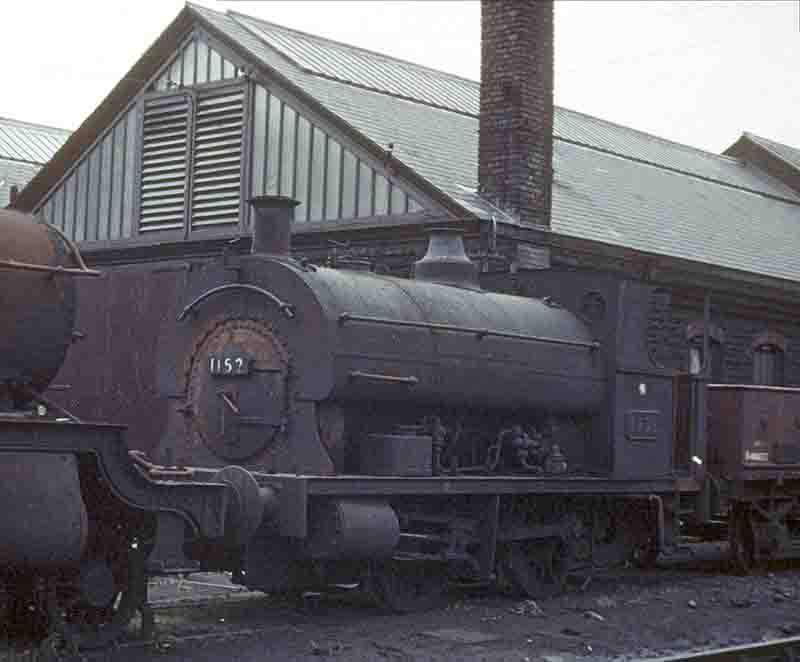
On a subsequent visit Peckett built ex Powlesland & Mason 0-4-0ST number 1152 stands in the shed yard at Danygraig.
Trips around the South Wales valleys soon gave rise to the realisation that there were actually locos that were not in the ABCs! It is difficult to imagine, in these days of instant information, how little the average gricer knew about what was going on, or where to find it. On a trip on a red Vespa scooter a good friend and I spotted a pannier tank, alongside a shed at a colliery in the valley between Pontypool and Crumlin. It turned out to be Great Western 2034, still with a Kidderminster shedplate on, which had not been in the books for years - and poking out of the shed was another pannier tank - No. 780 - a GWR rebuild of a Barry Railway saddletank.
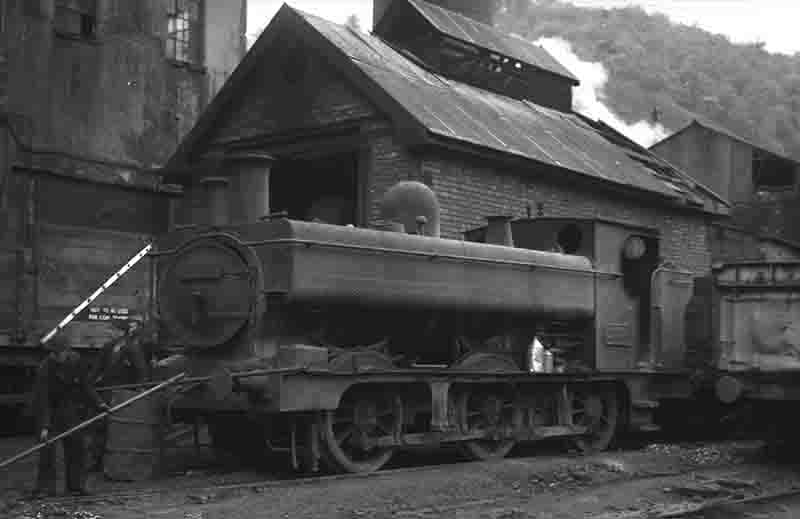
Former GWR 0-6-0PT number 2034 stands outside the old shed at Hafodyrynys colliery. She was sold to the NCB in 1955 & had previously worked at Caerphilly Tar Plant.
I joined the Birmingham Locomotive Club (later the Industrial Railway Society) and discovered their Pocket Books which gave lists of fascinating "industrial" survivors, but even they were being scrapped just as quickly as BR stock. Narrow gauge industrials with the delights of the Welsh Slate quarries, Sittingbourne, and the last of the ironstone railways of the East Midlands were still available. The first visit to Penrhyn slate quarries: five locos in steam, many others lurking in sheds and the famous line of withdrawn locos at the works, was an unforgettable experience - on a par with my first trip to Swindon Works! At Dorothea slate quarry, after seeing a very rusty stored two foot gauge Bagnall, "Wendy", we were asked "Don't you want to see the other one?" "What other one?" we replied, and were taken up a long disused incline to discover the derelict remains of a Quarry Hunslet in a collapsed shed! The loco was "Dorothea" (now restored and working at Launceston!) and the colour shot I took with Snowdon in the background is one of my treasures.
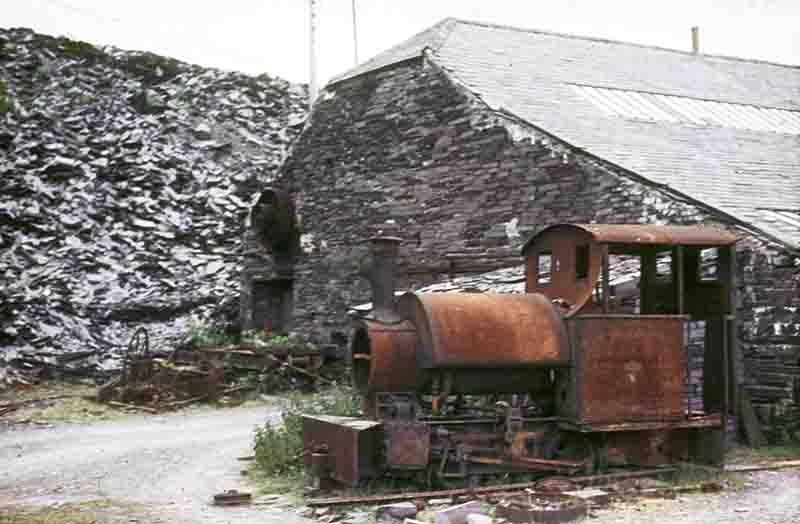
Bagnall 0-4-0ST "Wendy" stands derelict in the yard at Dorothea Slate Quarry having been out of use since the 1940s.
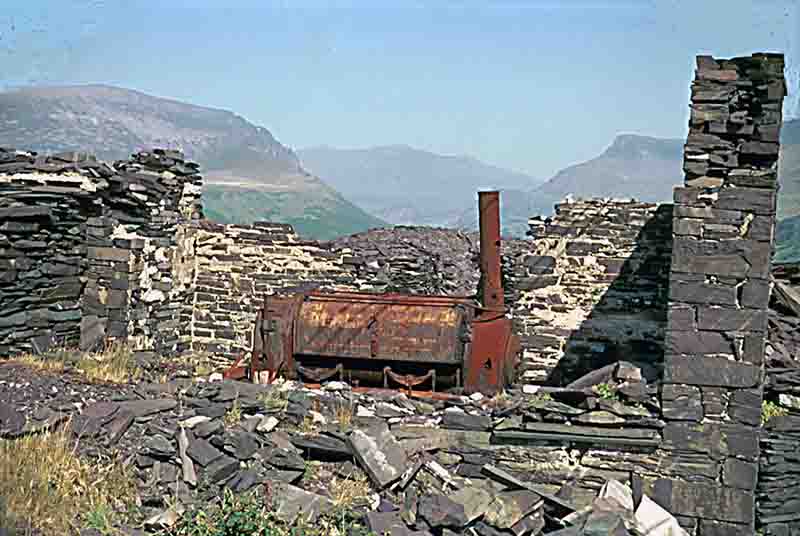
2ft gauge Hunslet 0-4-0ST "Dorothea" out of use since 1942 stands in her shed that has collapsed around her on the top level at Dorothea quarry. The chimney on the smokebox is the shed vent not the locos. Photo Tony Bowles - Mike's not scanned
Living in Great Western territory my main love was for the Kings and their untimely mass withdrawal in 1962 was certainly a wake-up call - just a minor fortaste of the next six years. It all happened so quickly. So, you might be forgiven for thinking that my interest in the main line died with the Great Western Kings. The thrill of the main line with its, its power, speed, along with the special anticipation of what loco was to come next was an experience that is now impossible to recreate.
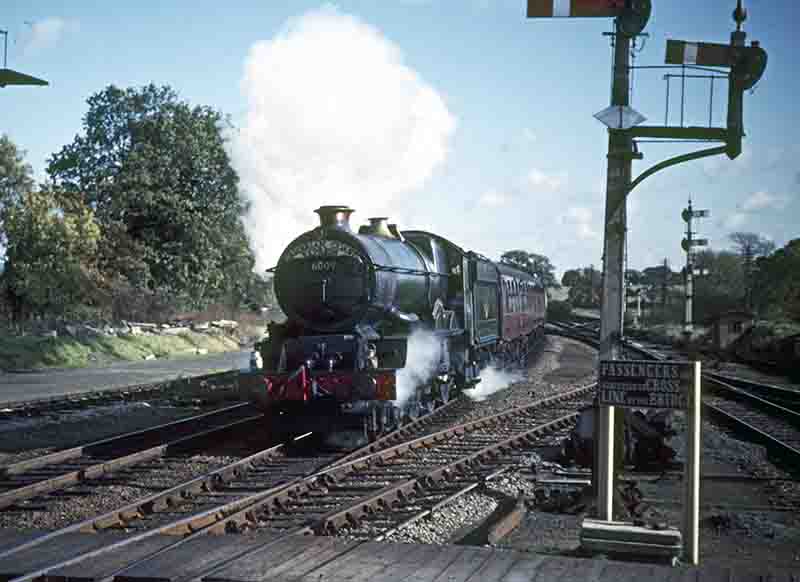
Ex GWR King class 4-6-0 6009 King Charles II heads the down Cambrian Coast Express through Hatton station at speed in September 1961.
In those days we didn't have cars and you couldn't afford them - not if wanted to buy film! My trips
were by train or on the good old faithful bicycle. A week in North Wales doing the slate quarries carrying
everything with me kept me fit and the climb to the top of Llanberis pass from Beddgelert (on a sunny
morning) was an experience not to be forgotten.
When I started working in 1960, Saturday mornings were
part of the working week and holidays had to be taken when you were told to have them. Time was at a premium,
film cost a small fortune and the weather was as fickle as it is today. So you had to make the most of what
you had. When you could afford it, travel was done by train, which at least gave you the chance to sort out
the "phot spots" for the future. Travel behind Dukedogs over the Cambrian, S&D 2-8-0s over the "Slow and Dirty"
and thrashes up the East Coast Main Line behind A4s are happy memories. Shed bashing was a favourite pastime,
often "bumking" (getting in without a permit and doing all you could to avoid the foreman) and equally often
being thrown out. Despite that, at a lot of sheds and sites there was relatively free access - in the days before
Health and Safety , the Environmental Protection Act and our "Nanny" society - it is difficult to imagine now.
The bunking extended to industrial sites - the collieries were virtually open house. At some shed and industrial
sites you were frequently welcomed with open arms and, as often or not, a very welcome cup of tea.
Not too late, I became frustrated with static shed shots and station photography, remembering what had first motivated me, first Tom's shot of "Bath Abbey" and later, like many of us, the lineside action captured by the late Bill Anderson. His "Trains in the Landscape" style was the target to achieve. Looking back at my early negatives and colour I realise, that like most of us, there is a list of missed opportunities. Hindsight is a wonderful thing - if only!!! Too many shed shots.
We eventually realised (often the hard way) that it would end even when closures happened and whole classes were withdrawn overnight, there were still other things to move on to - it all seemed relatively permanent. I lived very near the former Stratford and Midland Junction (Slow, Mouldering and Jolting as it was better known to us locals) line to Fenny Compton, Blisworth and beyond, but I can count of the fingers of one hand the decent photographs on the section up to Goldicote summit from Stratford Old Town. It seemed like it was always going to be there. Suddenly closure came in 1965 and it was gone forever.
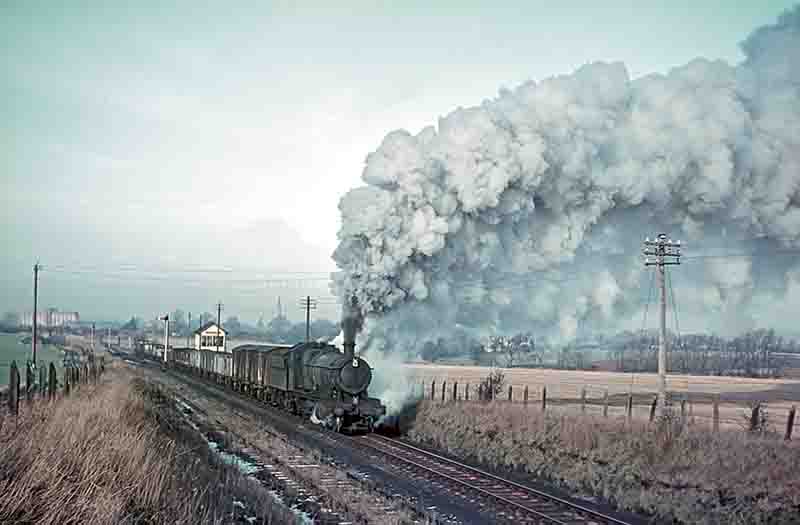
Ex GWR 2-8-0 number 3846 climbs away from Clifford Sidings signal box on the SMJ with an eastbound freight bound for Banbury via Fenny Compton on 23/1/1965.
Then in 1966 I met Paul Riley and was introduced to the adventures and information resource that was the MNA. After that it all seemed a lot more productive, the action shot count ratio improved and some very long lasting friendships developed. Right up to the end of BR Steam in 1968, there was still the delight of something to be photted and as often as not cleaned beforehand. And then suddenly reality dawned - On that fateful day of August 11th, a group of us sat at Smardale on the Settle and Carlisle and said "It will never be the same again" - I think history has proved us right - it hasn't.
We had started to drift off to Europe in 1965 and the 100 year olds gems in Spain were still waiting for us - but somehow it wasn't the same as sitting in the Lune Gorge waiting for the Red Bank parcels to Carlisle, or turning up at Rose Grove to clean the 8Fs before an early morning thrash up Copy Pit.
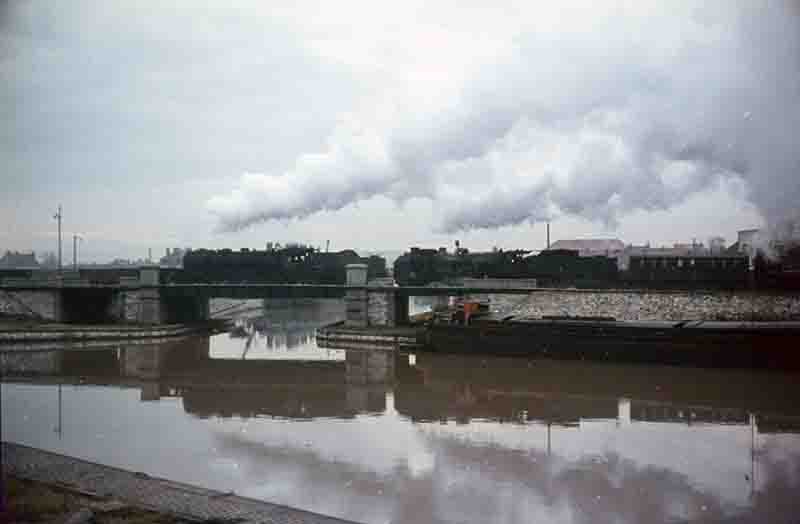
Mike's first trip over the Channel was in December 1965. Here an SNCF 141R 2-8-2 pilots a 231K Pacific away from Calais Maritime on a boat train.
In the days of the MNA we did what we could to clean them up - groups now try to dirty up the pristine
perfection of preservation.
NO - IT HAS NEVER BEEN THE SAME AGAIN"
Some personal recollections of travels with Mike illustrated with his pictures
Our first lengthy bicycle trip was over the August Bank Holiday weekend in 1962. Leaving Stratford on Saturday morning we first called at Weedon on the main line from Euston to photograph a number of passing expresses, then on via Kettering Ironstone to the St Neots area on the East Coast main line before starting south down the A1 in the evening. On Sunday morning we continued on down the A1 into central London and visited Nine Elms shed on our way past before continuing down the A2 to Sittingbourne in Kent. Here we slipped into Bowaters Paper Mill whilst the gateman was not looking and went all the way to Ridham Dock without being challenged. After this it was on into East Sussex and an overnight camp near Horsted Keynes where we awoke to a grey day that went steadily downhill. After a visit to the Bluebell we got somewhere north of Guildford before it started raining and we arrived back in Stratford after dark soaked to the skin.
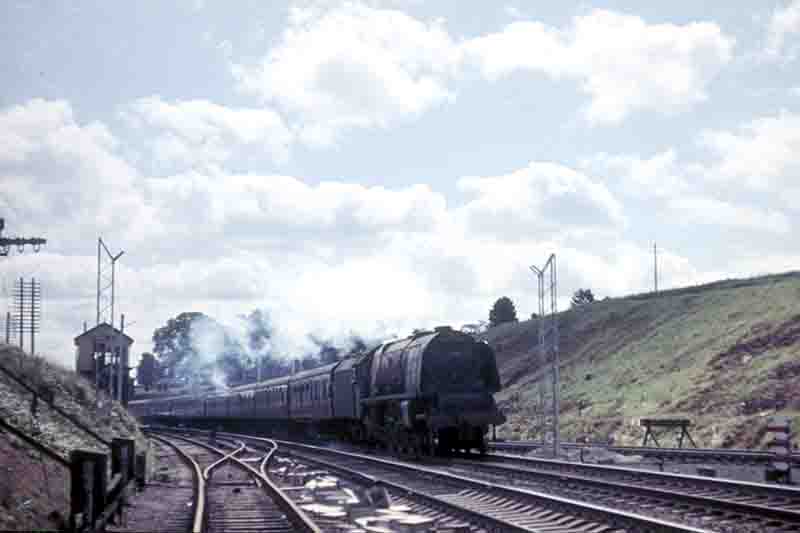
Ex LMSR Coronation class 4-6-2 number 46254 "City of Stoke-on-Trent" passes Weedon on a down express on August Bank Holiday Saturday in 1962.
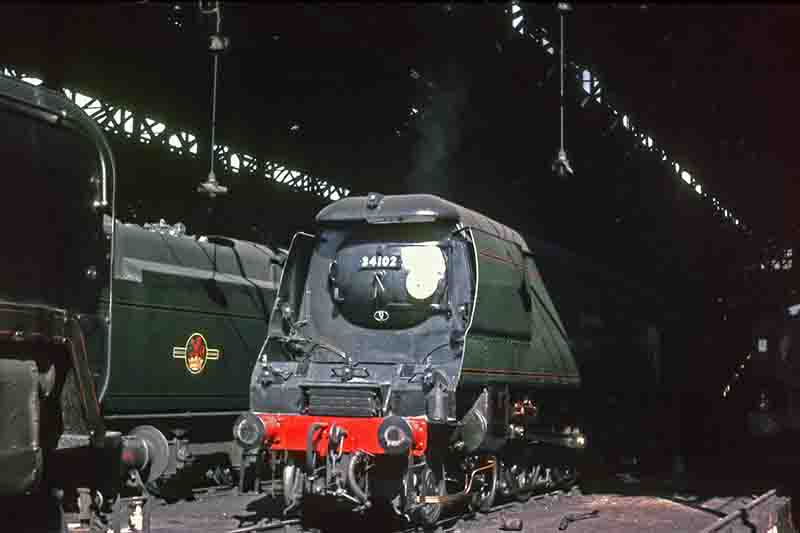
SR designed West Country class 4-6-2 number 34102 "Lapford" stands in Nine Elms shed on August Bank Holiday Sunday in 1962.
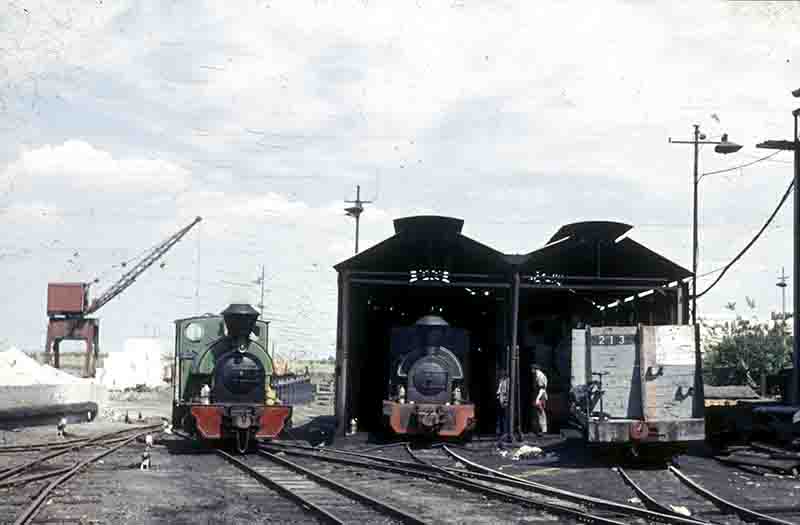
On the 2ft 6" gauge system at Bowaters a pair of the their 5 Kerr Stuart 0-4-2STs stand around the shed at Sittingbourne Works on August Bank Holiday Sunday in 1962.
In his notes above Mike referred to trips to the North Wales slate quarries which happened in both 1962 and 1963. These were again by bicycle from Stratford but the 1962 trip was cut short by the very unsettled weather, the only day with results of a sort was at Penrhyn. However 1963 was very different with settled weather all week and although starting in North Wales, it ended up in Swansea. Again it involved roadside camping and a couple of memories stick in my mind regarding this, the first was being woken up on a hillside above Brynglas on the Talyllyn by the chomping of sheep right outside the tent. The other occasion was at the side of the A44 just outside Aberystwyth when we sat inside the tent in the evening when a policeman came along and knocked on the tent pole. On seeing him we thought we were going to asked to move on but instead he simply asked whether we had seen someone they were looking for. Anyhow regarding the trip we started off from Stratford around 4.00am and reached Caersws west of Moat Lane Junction on the Cambrian main line aound mid morning. Here we photographed some trains crossing the timber bridge over the River Severn before moving on to camp somewhere north of Harlech that night. Travelling on in the morning to visit Boston Lodge on the Ffestiniog before continuing to Penmaenmawr for Welsh Granite, finally camping alongside the former Penrhyn main line to Port Penrhyn closed a couple of years previously. The next day was at Penrhyn Quarries before moving on to Llanberis, the Festiniog again and Talyllyn on subsequent ones. The evening following the visit to the latter we reached Aberdovey where we were able hire and a man with his outboard engine fitted boat to ferry us and our bikes across the Dovey estuary to Borth, so avoiding the long detour through Machynlleth to cross the river on the road. So after spending a day around Aberystwyth covering both the main line and the Vale of Rheidol we carried on through Carmarthen to Swansea to take photos around the docks.
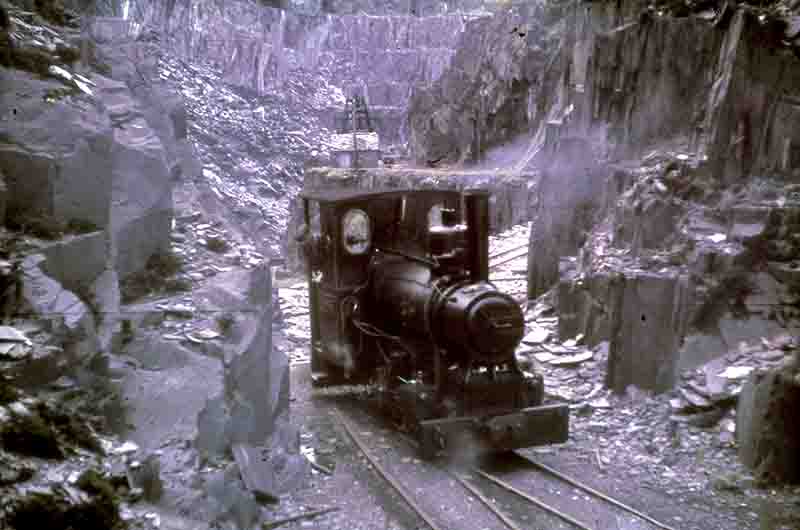
On the 1ft 10.3/4" gauge system at Penrhyn Andrew Barclay built 0-4-0WT "Cegin" runs light out of one of the quarry galleries in 1962.
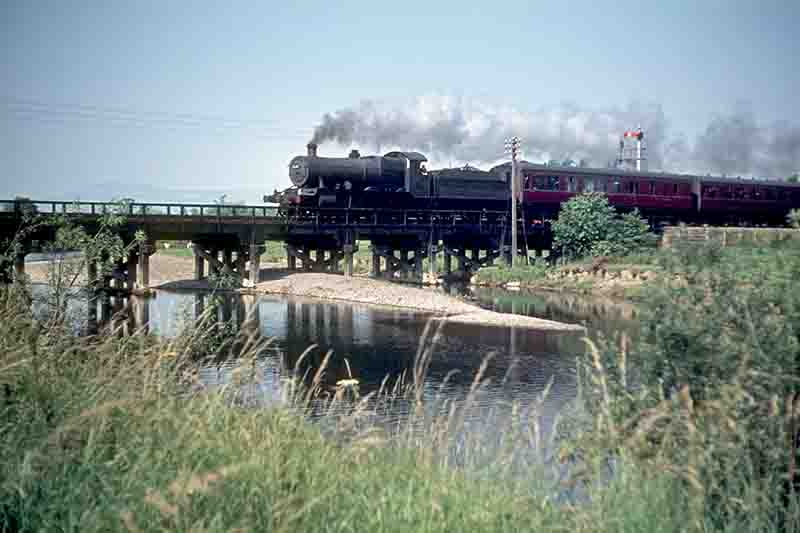
Ex GWR 4300 class 2-6-0 number 6368 crosses the River Severn east of Caersws station with an up Saturday holiday working.
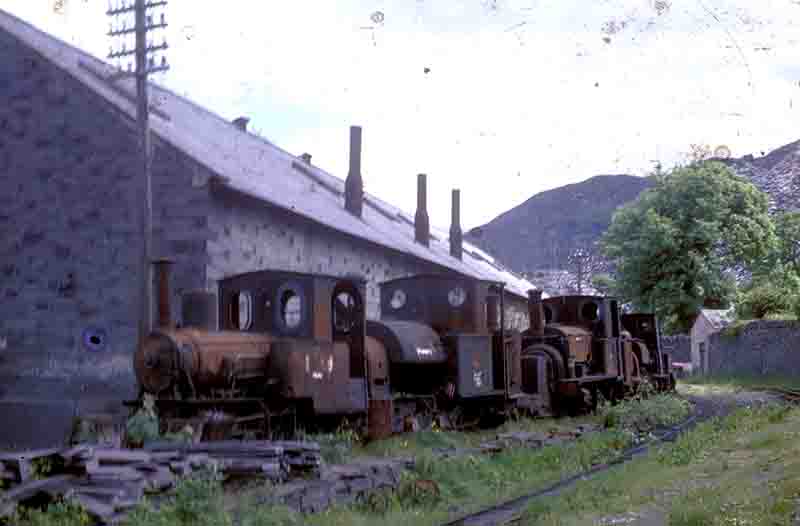
The scap line outside the workshops system at Penrhyn which in a mini sense proved to be the forerunner of Barry.
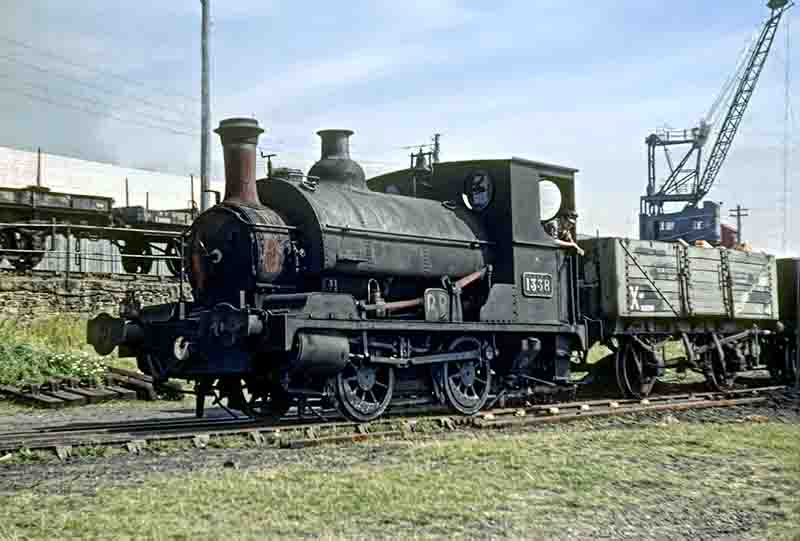
Ex Cardiff Railway Kitson built 0-4-0ST number 1338 shunts the system in Swansea Docks in August 1963.
1964 was the first use of motorised transport in the form of my father's Ford van and the holiday trip that year took the form of a fortnight long visit to Scotland and north east England that took advantage of the greater range possible, concentrating, but not exclusively, on industrial systems which held a particular fascination for Mike. These were in Fife and around Glasgow and Edinburgh before moving on down for what was largely a tour of County Durham.
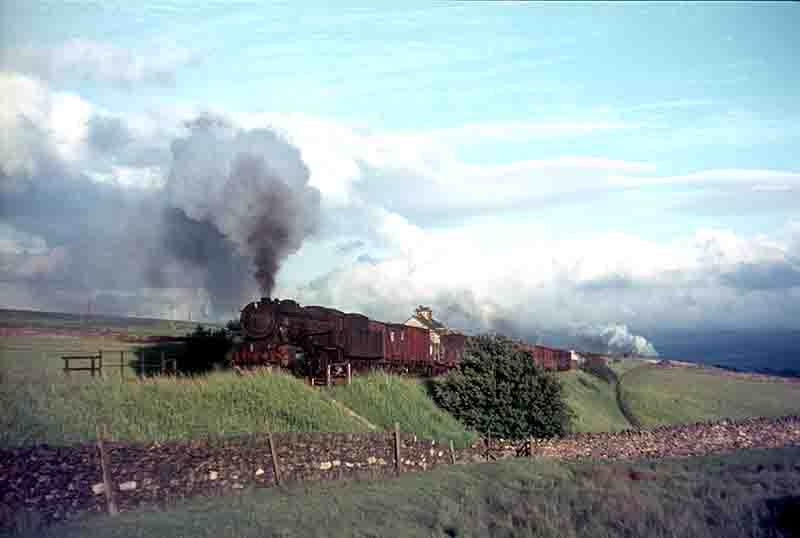
WD class 8F number 90181 climbs past Shap Wells with an evening down freight bound for Carlisle being banked by a Fairburn 2-6-4T on 27/06/1964.
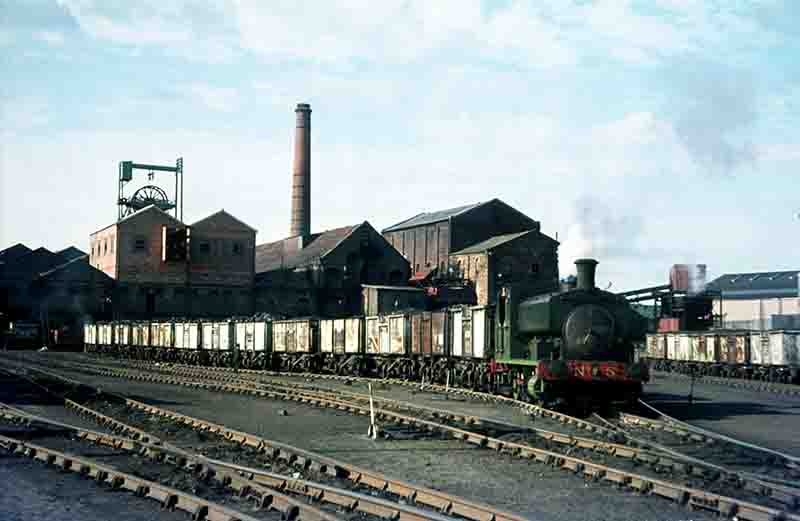
0-4-2ST No. 5 built by Grant Ritchie & Co. shunts loaded wagons from under the screens at Lady Victoria Colliery, Newtongrange on 29/06/1964.
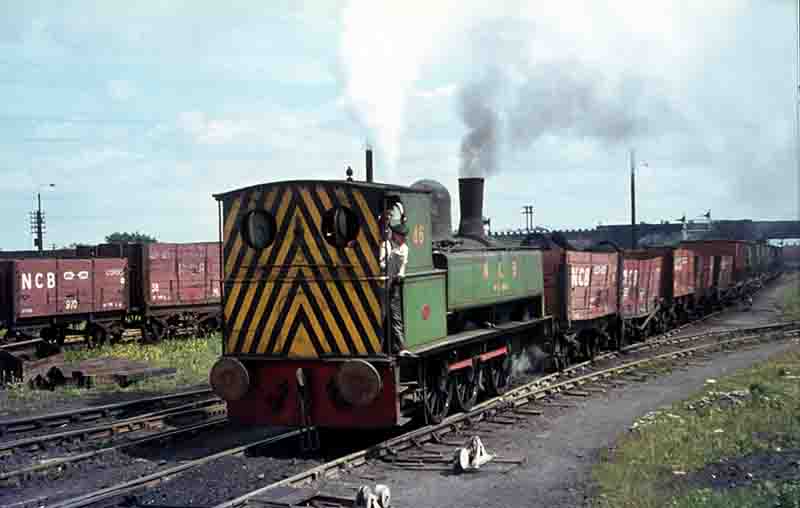
Former Consett Iron Co. 0-6-0PT number 46 based at Leadgate locomotive shed, near Consett, brings a load of coal from Eden colliery off BR? on 1/7/1964.
In 1965 I bought my own second hand Ford 100E van which performed sterling service over the following four years, and we agreed to share both the running and the maintenance costs between us. A good proportion of weeekends over this period were also spent chasing trains around the country. In spite of talk about a trip to Spain, the holiday in 1965 was an even more extensive tour of the UK from Aberdeen to Hampshire and Kent covering a mixture of main line and industrial locations. A small selection of the photographs taken are shown below which includes one at Bowaters Paper Mills at Sittingbourne visited with permission this time.
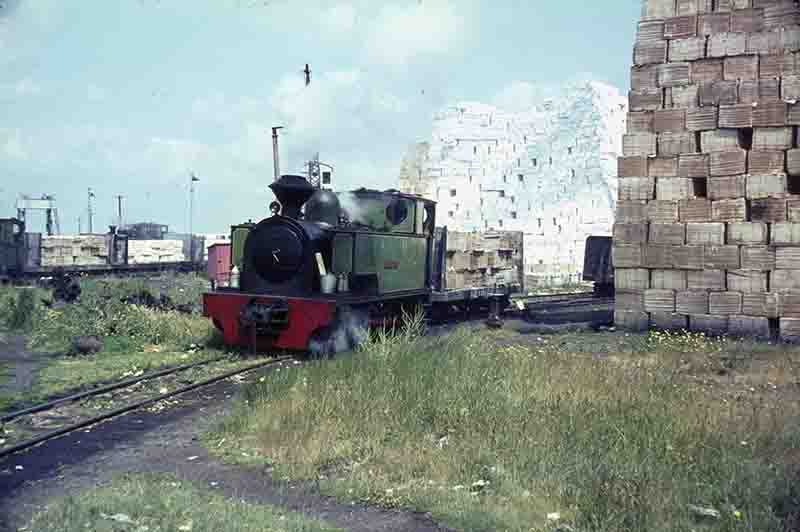
On the 2ft 6" gauge system at Bowaters Bagnall built 0-6-2T "Conqueror" shunts wagons loaded with bales of paper at Ridham dock on 5/07/1965.
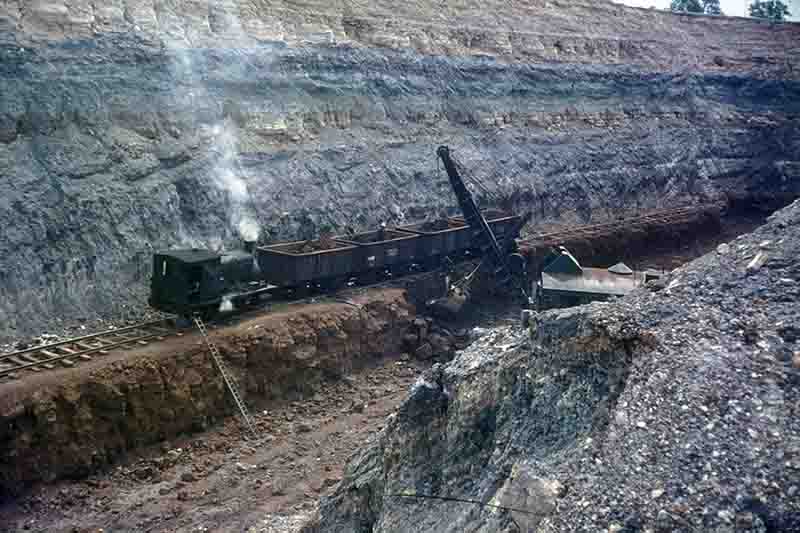
At Irchester Ironstone Quarries near Kettering Manning Wardle built 0-4-0ST number 14 has her wagons filled by the excavator at the quarry face on 7/07/1965.
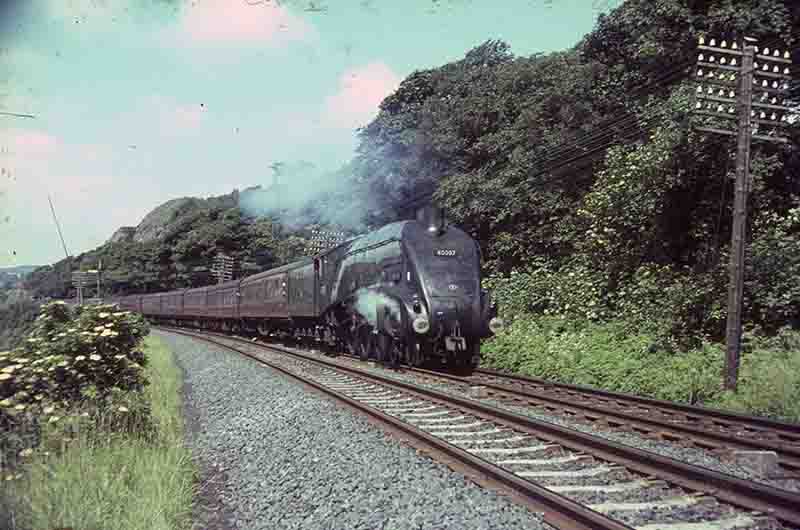
Ex LNER A4 class 4-6-2 number 60007 "Sir Nigel Gresley" climbs away from Burntisland with a down express on 17/07/1965.
In 1966 plans to visit Spain which Mike had been keen on since reading "Steam on the Sierra" turned into reality although they got disrupted by a ferry strike. We had to book a flight across the channel instead using British United Air Ferries between Lydd and Le Touquet. Once there we drove across France and entered Spain south of Perpignan to visit railways along the east coast and acoss the south of Spain to the Seville area. The surfaced but extremely uneven main road between Barcelona and Valencia eventually caused the van's exhaust pipe to break in two the engine side of the silencer. Mike got out his toolbox and the tube of an empty baked bean can was cut and wired in place to hold the two sections together. This "temporary" repair returned the noise level to normal, survived many miles of use over dirt roads and only fell apart again some months after our return to the UK.
There were three major objectives in our visit, firstly to visit some of the narrow gauge railways still operating at that time, then to photograph the pacific Garratts working the line between Barcelona and Valencia and pictures of the centenarian 0-6-0 and 0-8-0s at work in the country.
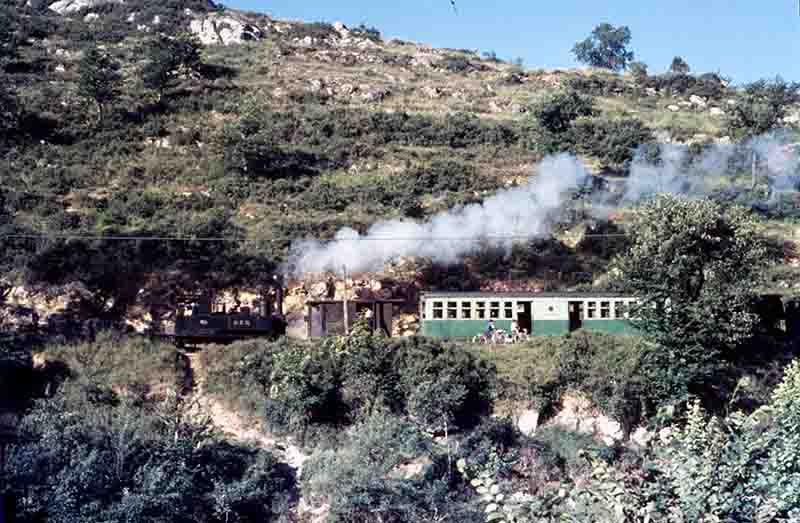
The first picture on the first morning in Spain 750mm gauge Krauss built 0-6-2T number 5 heads out of Gerona with a morning train to San Feliu on 11/06/1966.
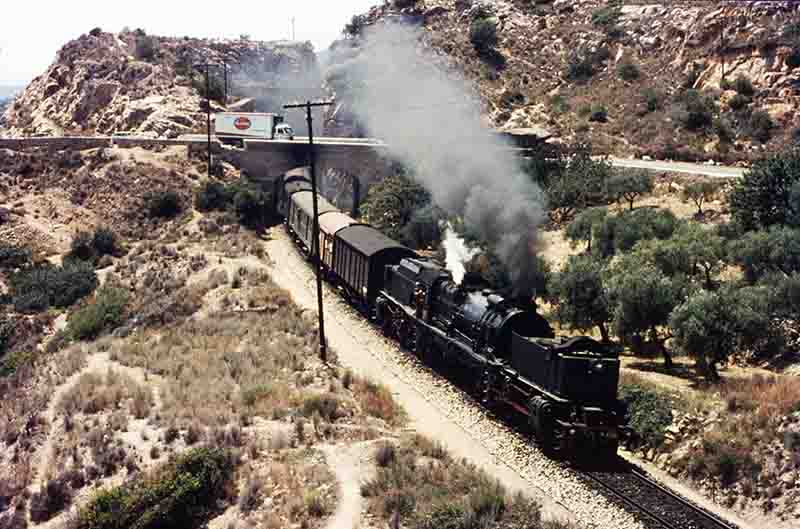
On the RENFE broad gauge lines ex Central of Aragon 4-6-2+2-6-4 Garratt number 462F-0405 built by Euskalduna in 1931 heads the 12.00 Valencia to Barcelona express near Benicasim de las Villas on 13/06/1966.
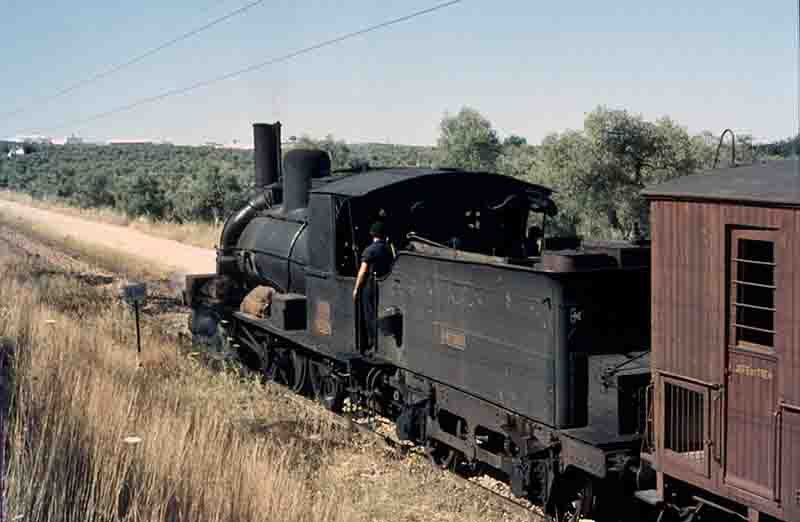
Also on the RENFE broad gauge just east of Seville, a centenarian ex Madrid, Zaragoza & Alicante 0-8-0 number 040-2051 approaches Carmona with a mixed train from Los Rosales on 20/06/1966.
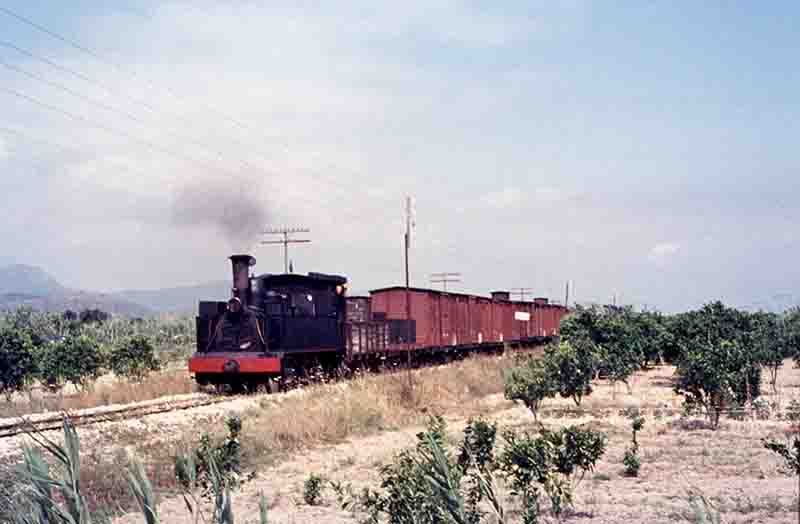
On the metre gauge FC de Carcagente a Denia Franco Belge built 0-6-0T number 25 heads a freight from Carcagente to Denia south of Gandia near Oliva? on 24/06/1966.
There was a short trip to Brittany over the Whitsun Bank holiday weekend to photograph the Reseau Breton, with Paul Riley carried in the back of the van. We did not realise it at the time but this was within a few weeks of the system closing. Later in 1967 saw a further expansion of the horizons with a trip right across Europe photographing in Austria, Yugoslavia and Greece. This time I picked Mike up in Leamington after he had finished work on Friday afternoon and we were driving out along the Southam Road heading for London when we were stopped for a traffic survey just out of Leamington. When asked our destination we said Athens but regrettably it was recorded as Dover. In Austria we visited a number of the 760mm gauge lines and paid our first visit to the glorious spectacle that was the Erzbergbahn (the standard gauge rack line between Vordernberg and Eisenerz), the primary purpose of which was to transport iron ore from the quarries above Eisenerz to the steelworks at Donawitz, just south of Vordernberg. In Yugoslavia it was the Austrian built 760mm gauge lines north of Sarajevo and down on the Adriatic around Dubrovnik that we wanted to see; and in Greece it was the 60cm gauge line east from Volos and the metre gauge lines on the Peloponnese south af Athens that were the focus of our attention. The motoring side of the trip was uneventful, other than the fact that the van was not happy with some high teperatures encountered. One day we were driving along the main road towards Athens at a maximum of about 35mph, because any faster and the temperature gauge started rising dramatically.
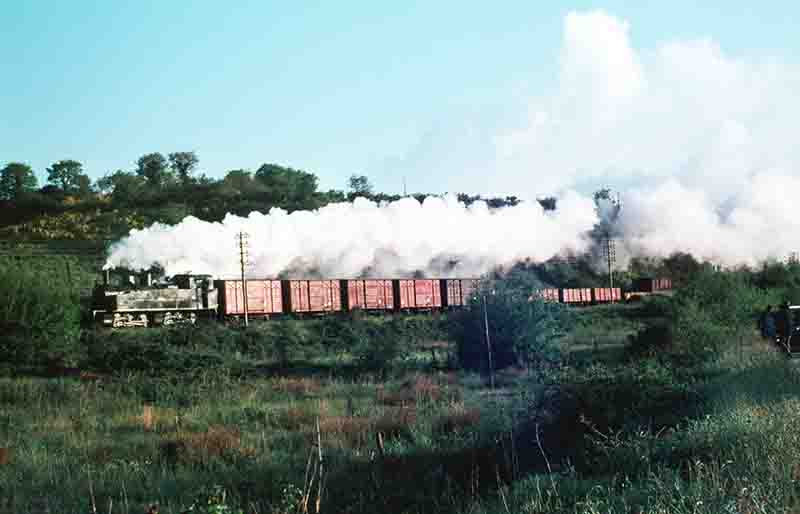
Piquet built 0-6-6-0 Mallet tank number E416 heads a freight from Carhaix to Rosporden between Motreff & Gourin on 29/05/1967.
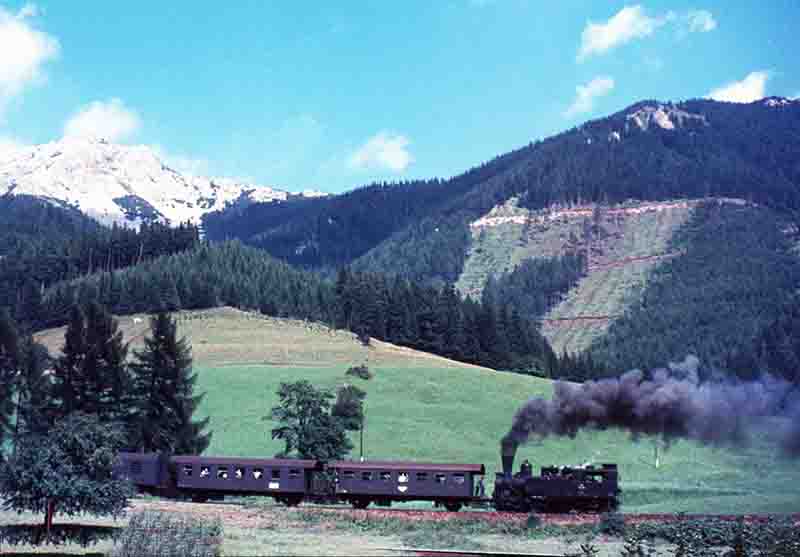
Osterreichische Bundesbahnen class 97 class 0-6-2 rack tank number 97.208 fitted with a Giesl Ejector heads away from the water stop at Glaslbremse with the early afternoon passenger train from Vordernberg to Eisenerz on 22/08/1967.
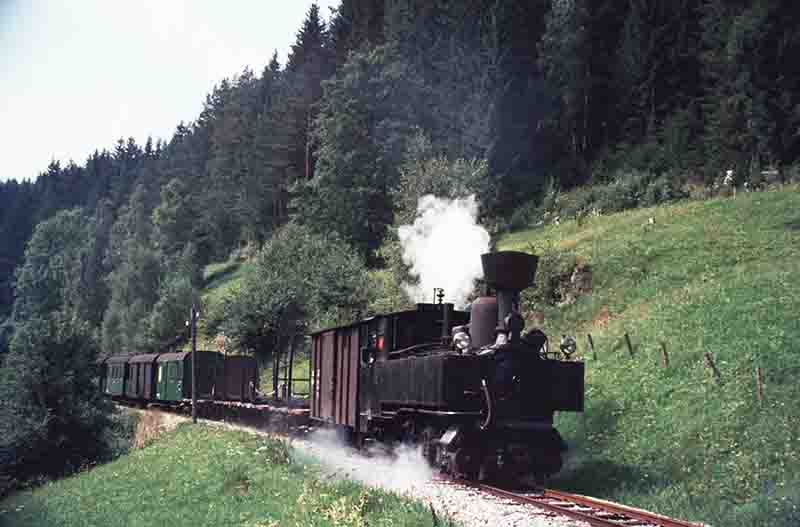
Also in Austria on the Steiermarkische Landesbahnen 760mm gauge U class 0-6-2T number U8 works the morning mixed from Weiz to Ratten on 22/08/1967.
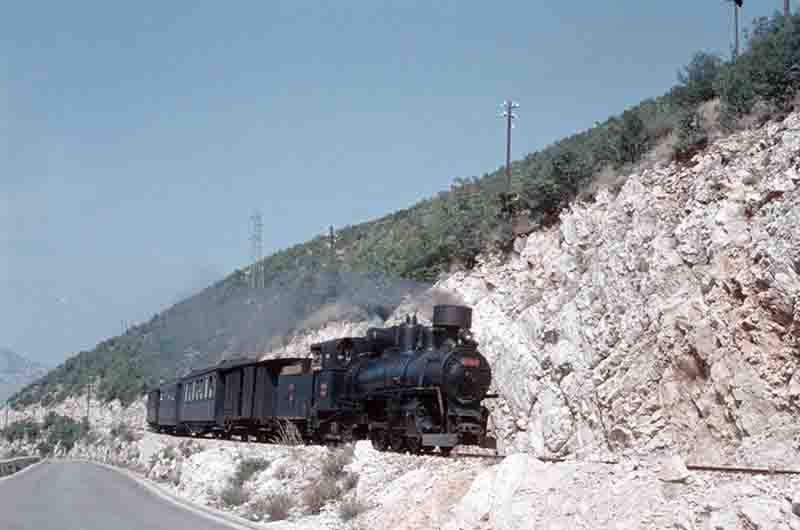
In Yugoslavia, class 83 0-8-2 number 83.017, built by Magyar Allami Vas in 1929, heads a Dubrovnik to Niksic passenger train east of Trebinje on 2/09/1967.
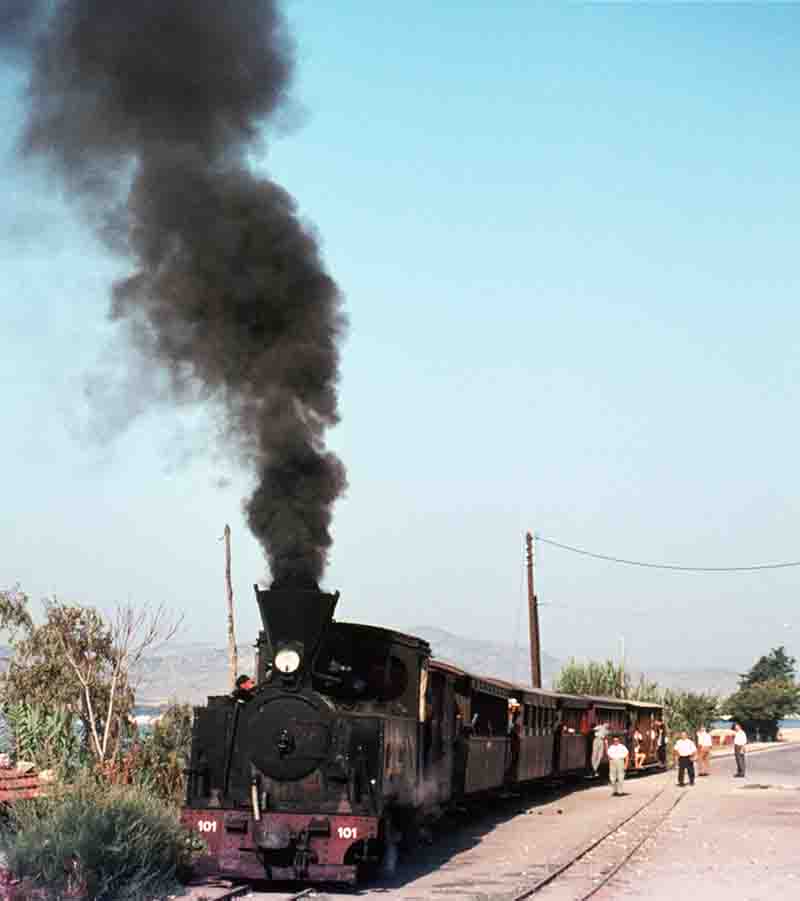
In Greece, on the 60cm gauge Pilio Railway east of Volis, Tubize built 2-6-0T number 101 "Mileai" heads the Sunday morning train to Milee standing at Anavros on 27/08/1967.
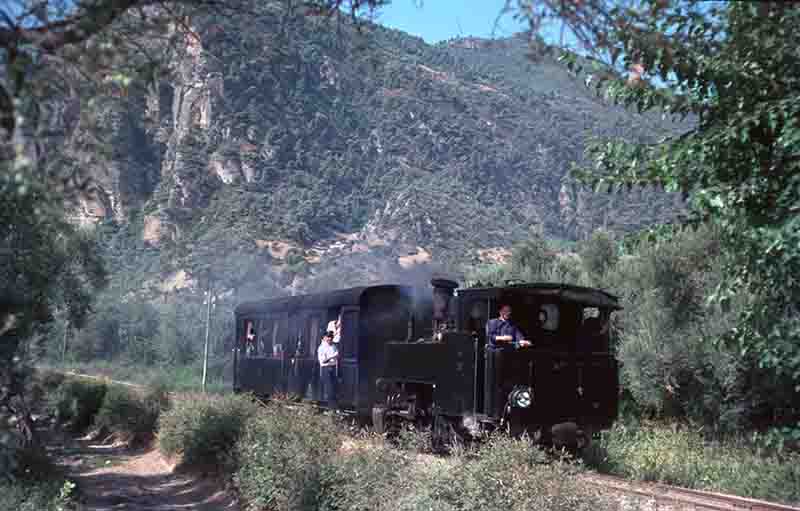
Also in Greece on the Peloponnes 750mm gauge rack fitted 0-6-2T number 8005, constructed at Piraeus works in 1954, approaches Diakofto with a train from Kalavryta on 28/08/1967.
In 1968, we first visited Austria & and Yugoslavia again in June but the weather particularly in Austria was dire, then following the end of BR steam, it was a return visit to Spain but this time covering the Continental Railway Circle's railtour over the Reseau du Vivarais, shortly before it's closure, on the journey through France. In Spain the focus was on the RENFE lines, the national network of broad gauge (1672mm) lines; with particular attention to the Garratts working between Tarragona and Lerida, and the Miranda de Ebro to Zaragoza line immediately east of the former. Whilst at Lerida it was also decided to check out reports in World Steam that the branch to Pobla de Segur was very scenic. This proved to be the case at north end where it reached the foothills of the Pyrenees.
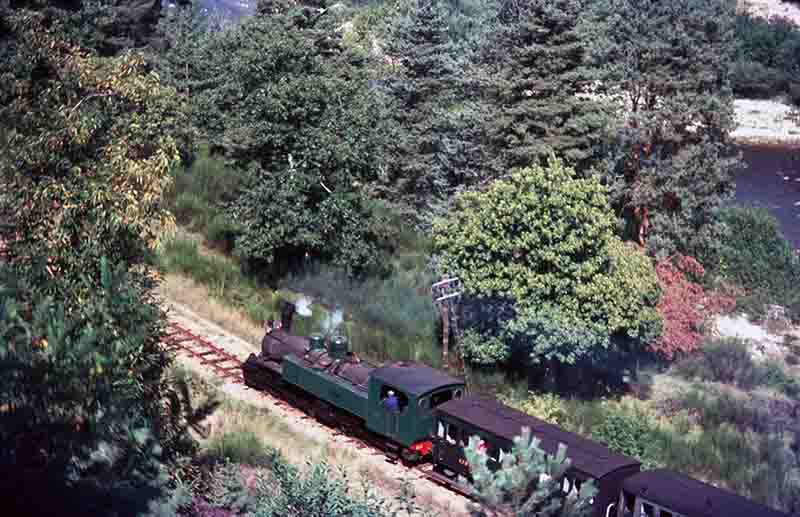
On the Reseau du Vivarais CFD 0-6-6-0 Mallet tank number 403 built by SLM heads a railtour near St Prix? on the climb from Lamastre to Le Cheylard in September 1968.
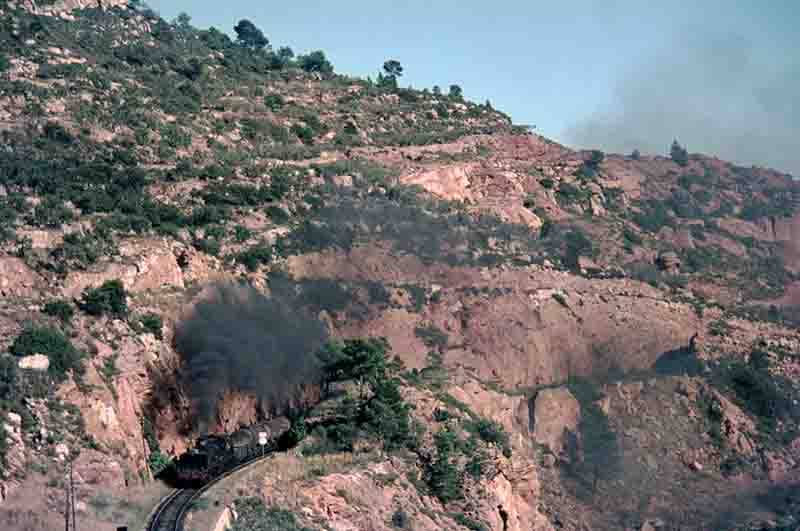
In Spain an ex FC Central de Aragon 2-8-2 + 2-8-2 Garratt built by Babcock & Wilcox in 1930 climbs away from Picamoixons with a Tarragona to Lerida freight in September 1968.
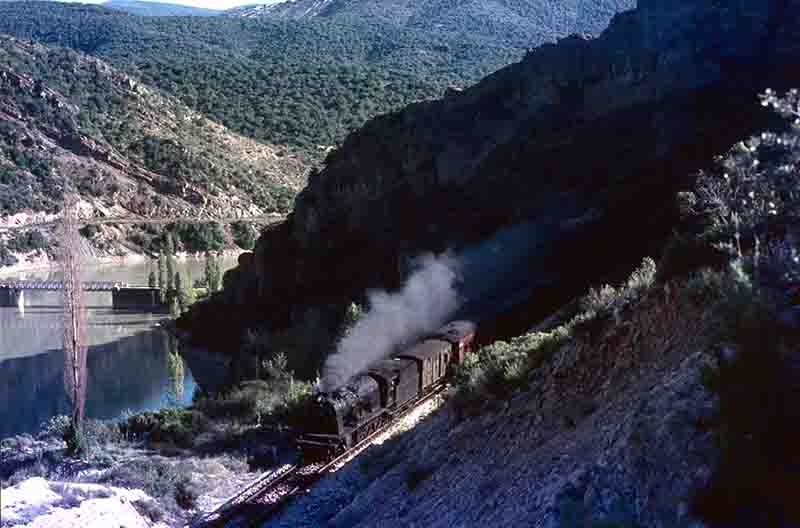
An ex Madrid, Zaragoza & Alicante 4-8-0 heads a Lerida to Pobla de Segur train approaching Selles in September 1968.
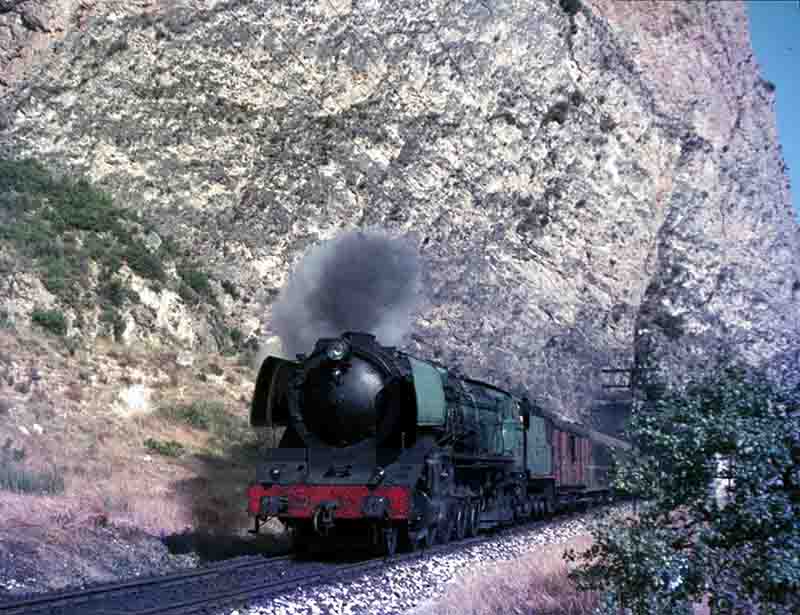
A RENFE class 242F 4-8-4, built by Maquinista in 1956, climbs away from San Felices along the south bank of the Rio Ebro with the Bilbao to Barcelona express in September 1968.
By the time of the 1969 holiday, the Ford van had retired itself!, so it was a fly-drive trip that took the form of a flight from Heathrow to Bilbao in a Vickers Vanguard, all 5 hours of it. Here we collected a Simca 1000 and immediately drove it out of the country and up into France to Tulle in Correze. Here another railtour had been organised by the Continental Railway Circle on the metre gauge PO-Correze. A two day one covering the whole of the system and on the second day we came across Dave Gouldthorp and Dave Lacey, who we gave a lift to for the remainder of the day and back with us into Spain, travelling over the Pyrenees and down to Pobla de Segur for more pictures on the line from Lerida.
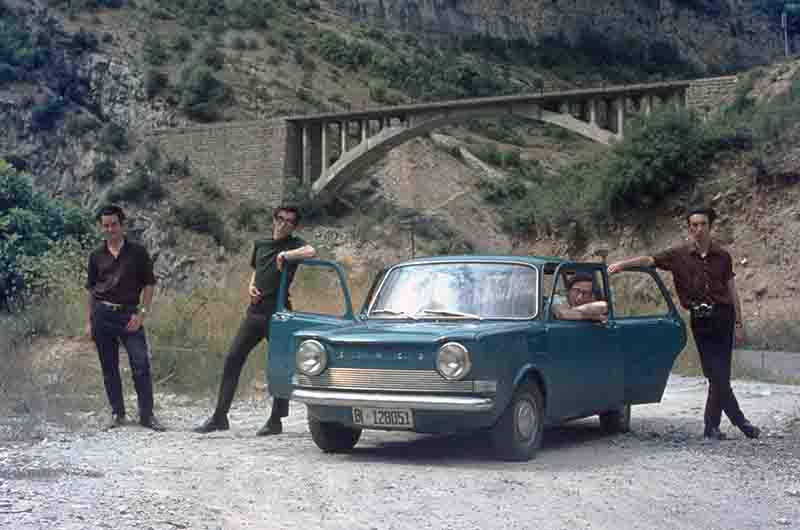
The Bilbao registered hire car stands in the gorge south of Selles on the Pobla de Segur branch with from the left Dave Gouldthorp, Mike Collins, Tony Bowles & Dave Lacey.
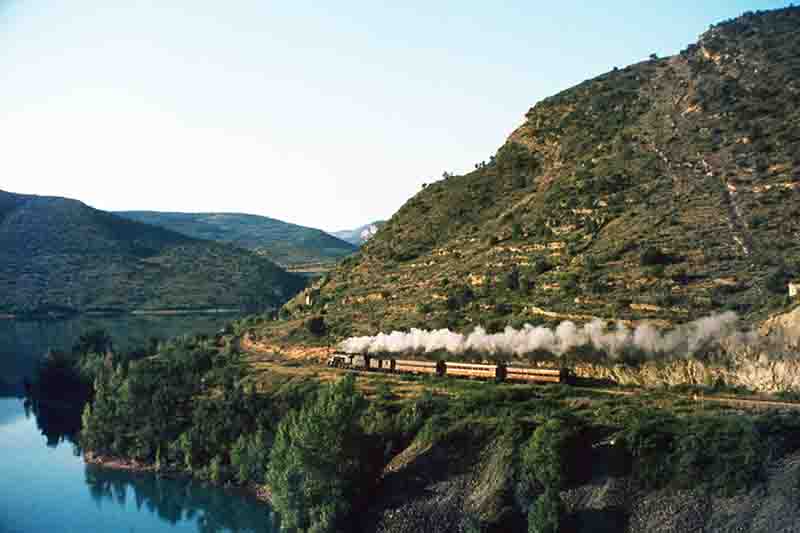
An ex Madrid, Zaragoza & Alicante 4-8-0 heads an early morning train from Pobla de Segur to Lerida away from Ager on 03/09/1969.
After a couple of days on the line, we parted company with Mike and I continuing on to Portugal for Mike's first visit. Here we concentrated on the Porto area and the Douro valley lines.
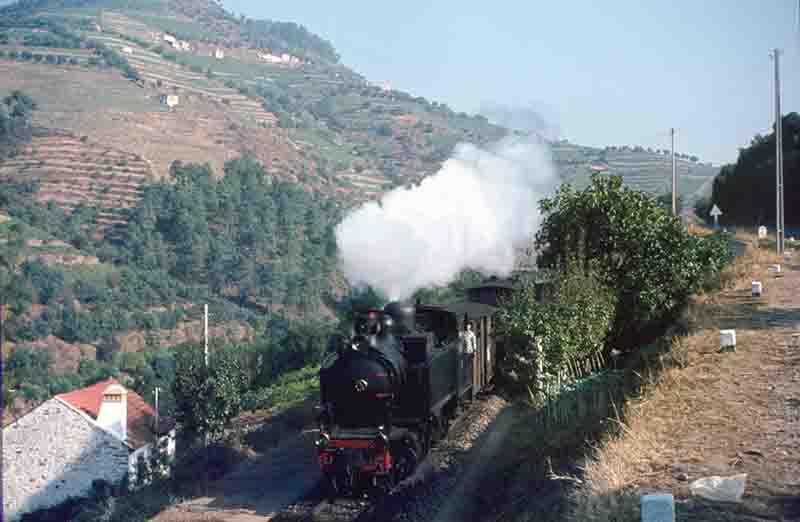
On the metre gauge Corgo line in Portugal former CF do Estado 2-4-6-0T number E207, built by Henschel in 1923, heads a Régua bound train south of Tanha on 09/09/1969.
There were two trips in 1970, the first to West Germany for a week in the spring travelling by train via Hook of Holland to Cologne. Here we picked up a car and drove down to the Black Forest area and returned via the Moselle line at Bullay. It was another fly-drive holiday later on, this time flying to Clermont Ferrand, collecting another Simca and driving it straight down into Spain for a few shots in the Salamanca area. It was basically another trip to Portugal covering the same area as the previous year but with the addition of the Vouga lines. On our return through Spain we also took the opportunity of visiting the metre gauge FC Ponferrada - Villablino.
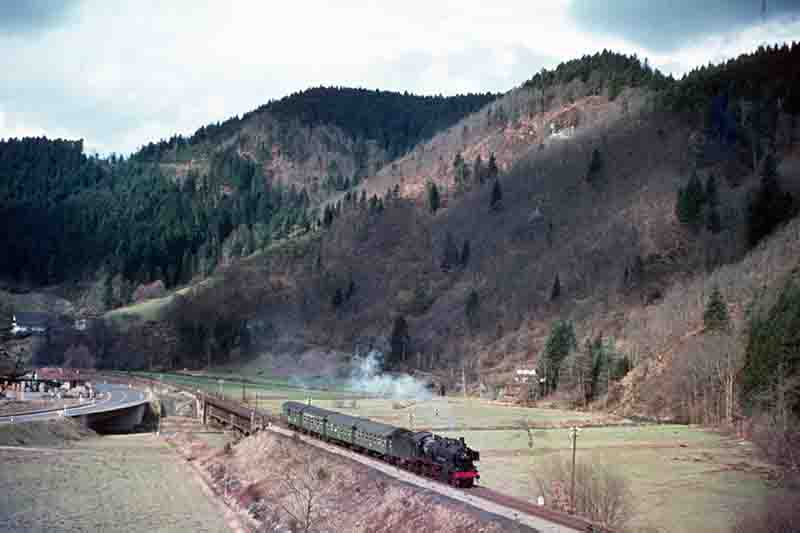
A class 38 4-6-0 heads a Hausach to Freudenstadt train near Schenkenzell on 31/03/1970.
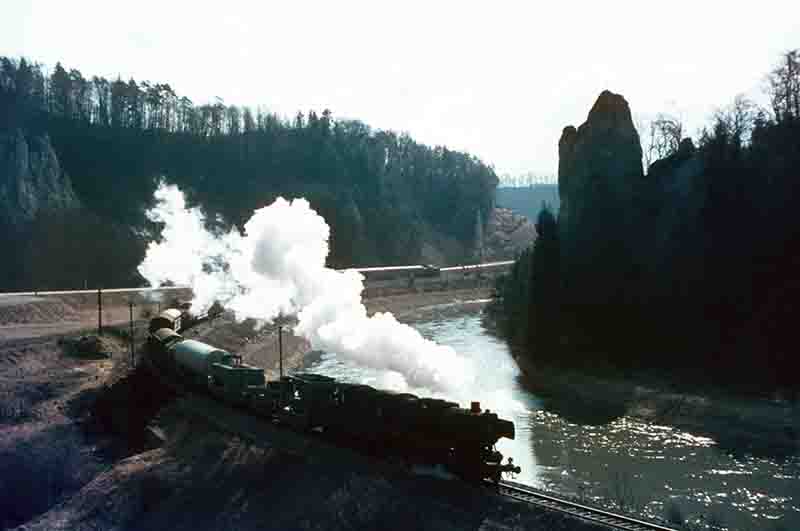
Class 50 2-10-0 number 050.305-5 heads a westbound freight along the bank of the River Danube near Inzighofen on 01/04/1970.
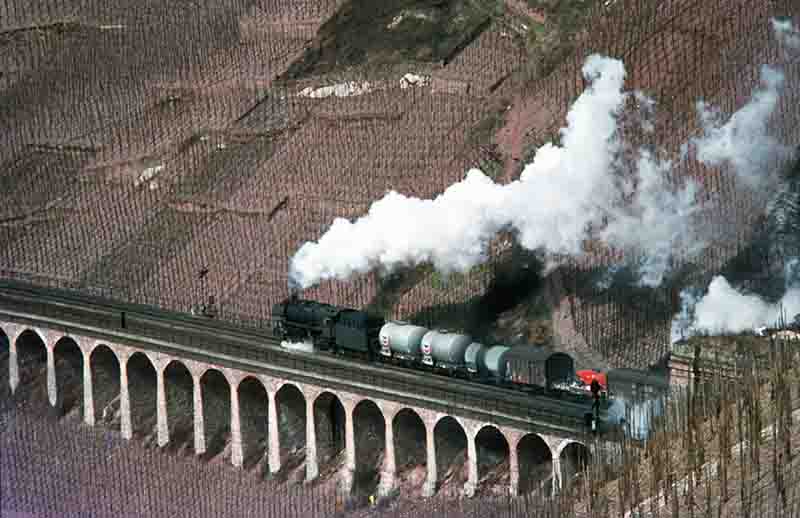
Photographed from the top of the hill overlooking the bridge at Bullay, a class 44 2-10-0 heads a southbound freight along the built up embankment at Punderichon on 3/04/1970.
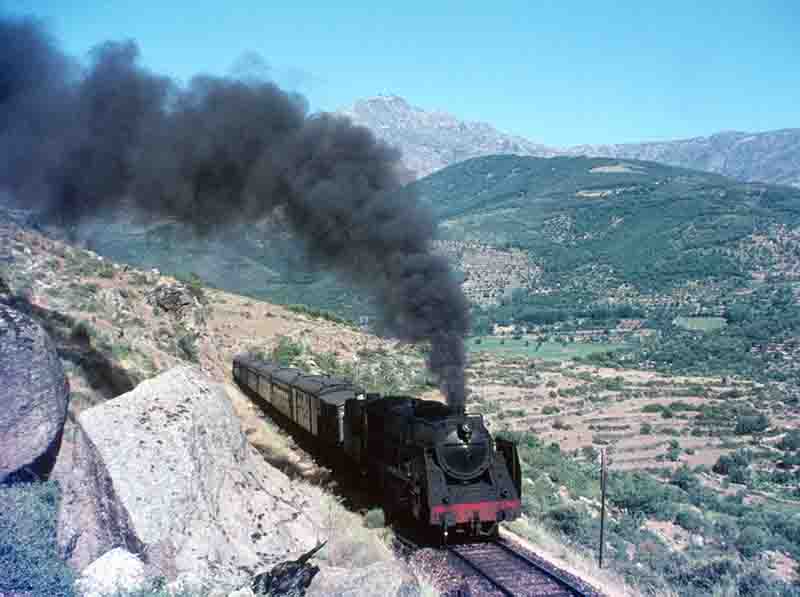
Ex Madrid, Zaragoza, & Alicante 4-8-2 number 241F.2088, built by Maquinista in 1931, and later modified like 2076-2086 with Debag water heaters & smoke deflectors, climbs from Hervas to Banos de Montemayor with an express to Salamanca from Plascencia on 26/07/1970.
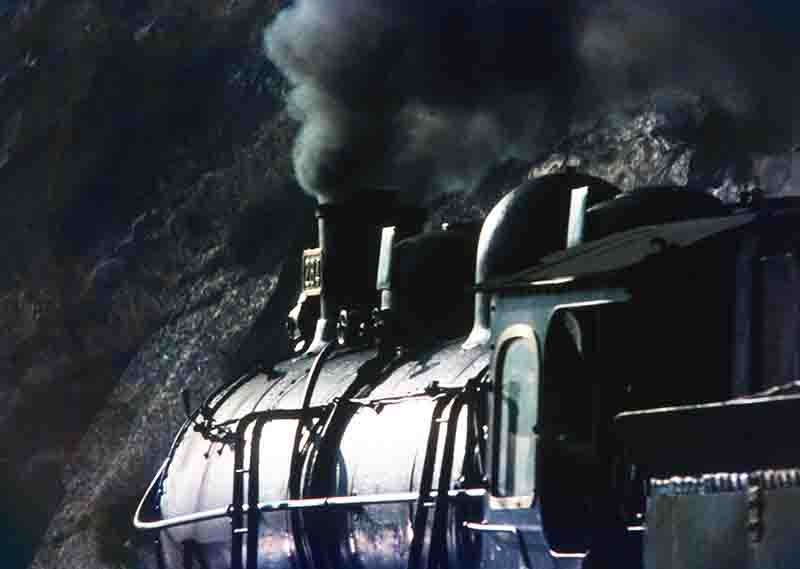
On the Douro valley line in Portugal, Henschel built 4-6-0 number 284 stands at Tua with the weekdays mixed from Pocinho to Régua on 27/07/1970.
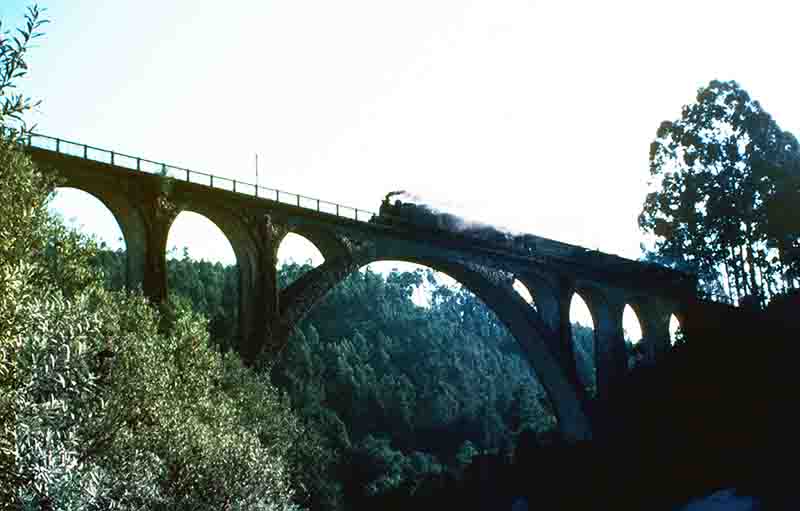
On the metre gauge line from Sernada, one of the 4-6-0Ts crosses the viaduct at Poço de Santiago with a train to Viseu on 1/87/1970.
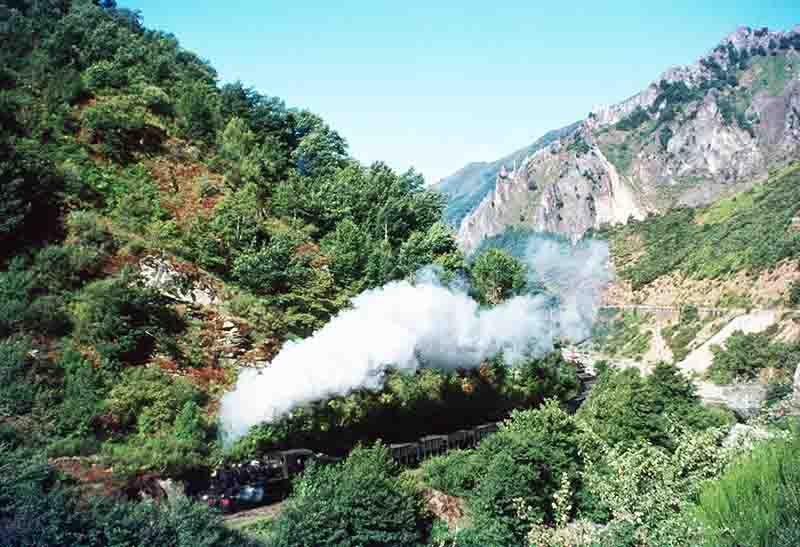
On the return through Spain, on the line from Ponferrada Engerth 2-6-0+4 number 18 built by Krauss in 1914, heads a train of coal empties for Villablino north of Cuevas del Sil on 6/87/1970.
In 1971 I purchased a new Mini-van and almost immediately acquired an extra couple of spares wheels and had them fitted with tyre studs. This was to ensure that we had no problems coping with snow conditions in Austria where we headed in February. First visiting the north of Austria, we then spent several days photographing around the Vordernberg area, before moving on down to the Dolomites in Italy for the weekly ski special on the line from Fortezza to San Candido. Next it as down into France and along the Riviera passing through Nice around 2.00am and on into Spain where they had been reports of Garratts working on the line from Valencia to La Encina. This however proved to be a fruitless search and the whole week in Spain produced nothing worthwhile - oh for modern communications. For the whole trip the weather was generally on the grey side.
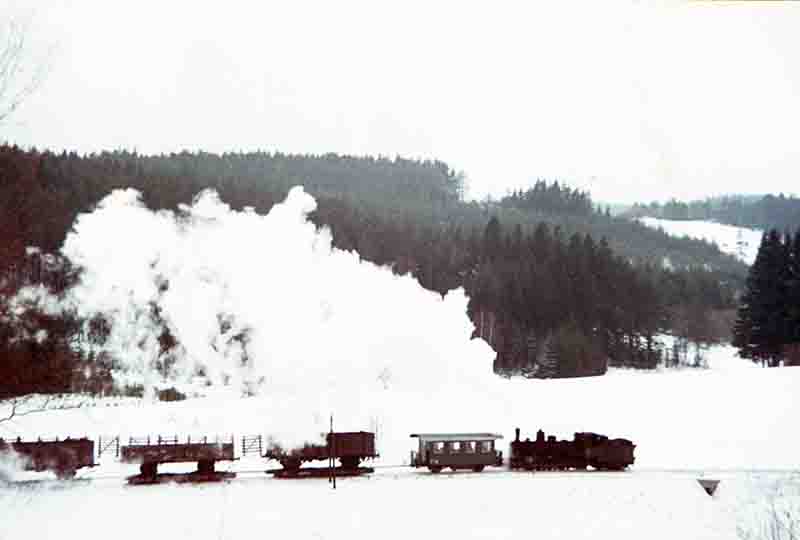
In Niederösterreich on the Waldviertelbahn, a 760mm gauge 399 class 0-8+4 climbs approaches the summit near Brudendorf with the freight from Gross Gerungs to Gmund on 08/02/1971.
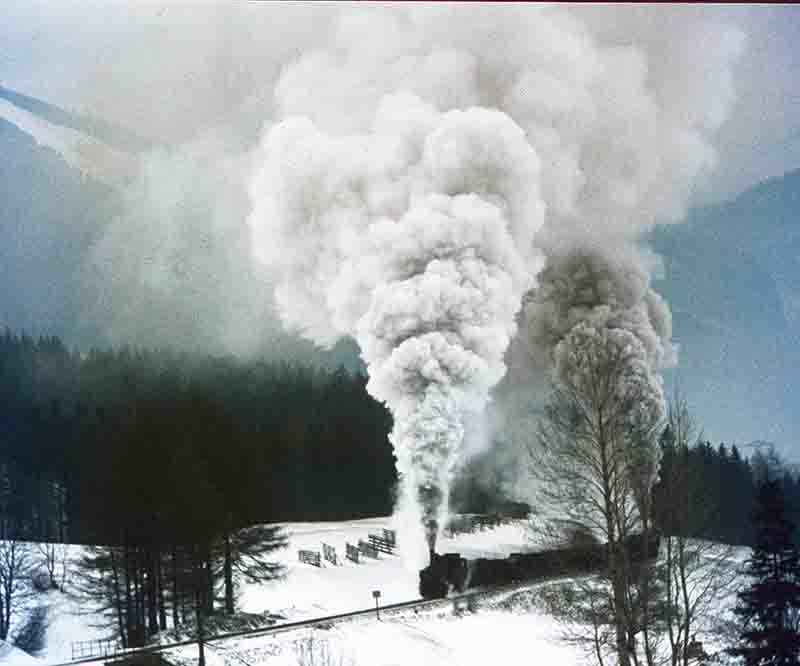
On the Erzbergbahn, a pair of 97 class 0-6-2 rack tanks work a train of iron ore empties up the gradient away from the water stop at Glaslbremse on the climb to the line's summit at Prabichl on 10/02/1971.
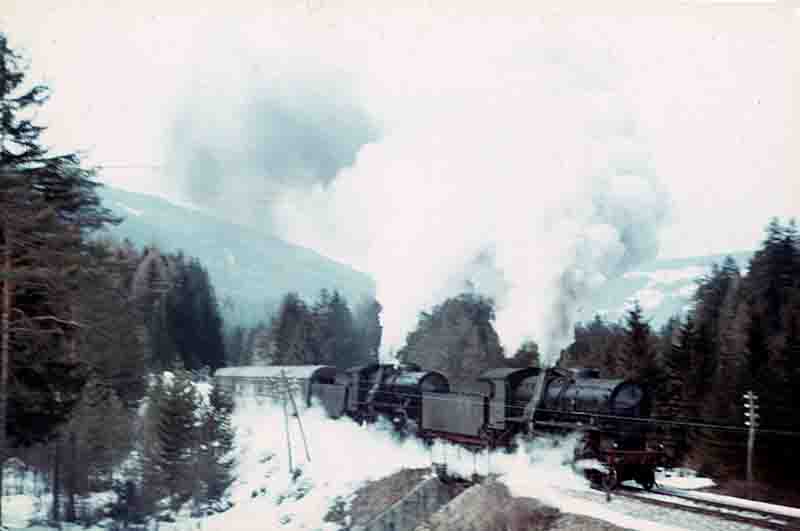
In Italy a pair of Crosti boiler fitted 741 class 2-8-0s with number 741.470, built by Henschel in 1922, leading head a Ski Special from Germany near Villabassa-Braies bound for Dobbiaco on 13/02/1971.
Mike married his first wife, Jacqui, later in 1971 and in 1972 we visited Portugal again, with Jacqui riding in the back of the mini-van, a fairly uncomfortable experience I would imagine.
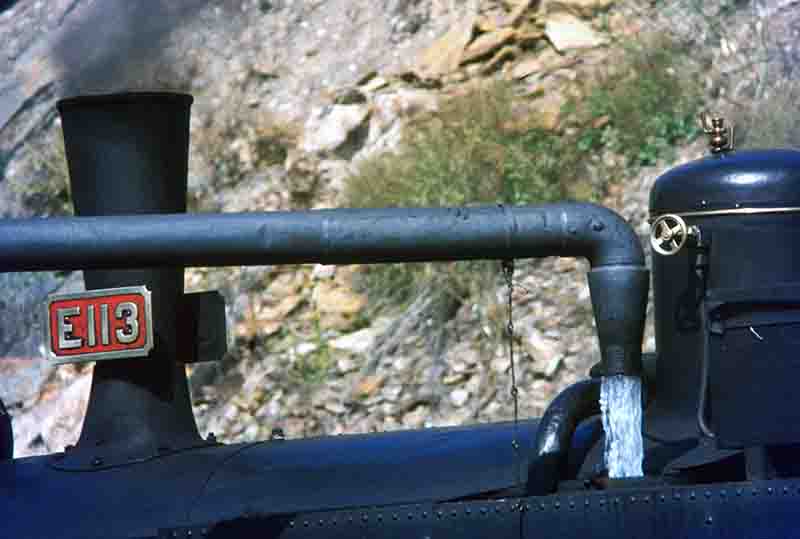
Metre gauge Kessler built 2-6-0T number E113 takes water in Tua yard prior to working the afternoon mixed train to Mirandela on 27/09/1972.
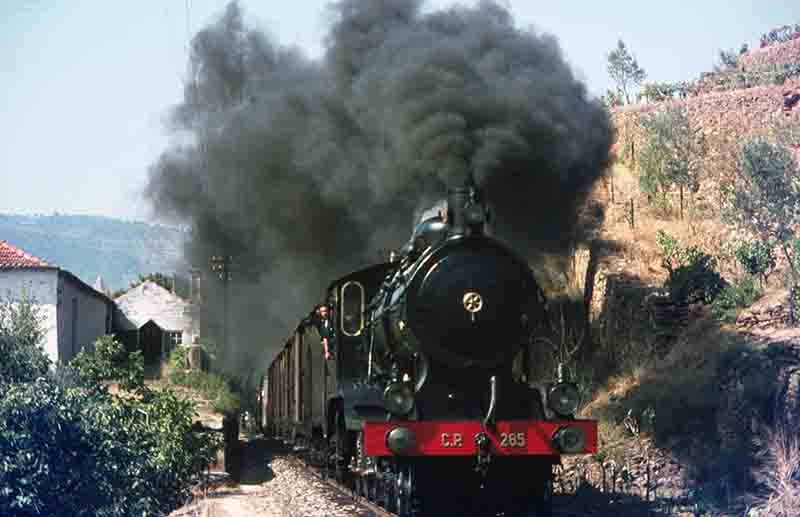
On the Douro Valley line, 4-6-0 number 285 heads the 12.45 Régua to Barca D'Alva away from Tua on 26/09/1972. A great response to the request for "mucho humo negro por favor" with the crew not being upset by the use of Spanish.
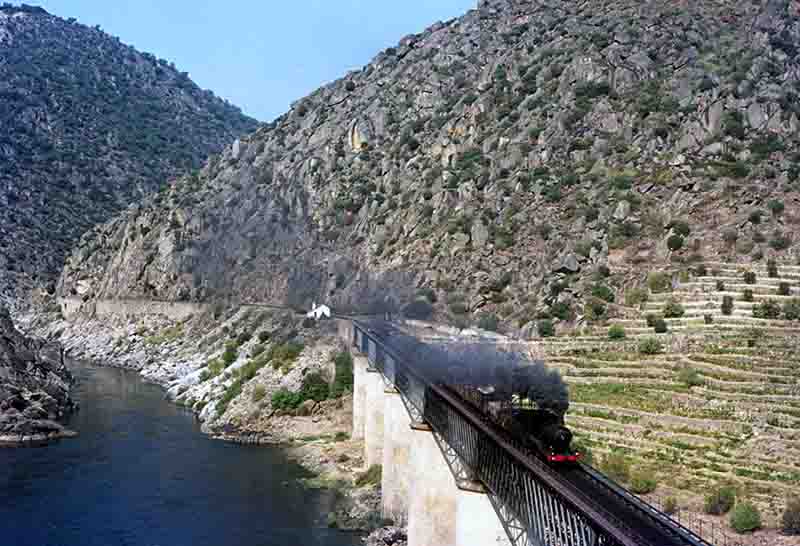
Further up the valley, 4-6-0 number 284 crosses the viaduct over the River Douro at Ferradosa with the weekdays mixed from Régua to Pocinho on 28/09/1972. The viaduct has since been replaced by a bridge further upstream due to the raised water level caused by the construction of the Valeira dam a short distance downstream.
1974 saw a return trip to Austria & the Dolomites in winter conditions. The weather was much kinder in Austria on this visit but still generally grey in Italy with vehicle use banned on the Sunday due to the fuel crisis at the time. On the other hand there were several days of sun with lying snow on the Erzbergbahn.
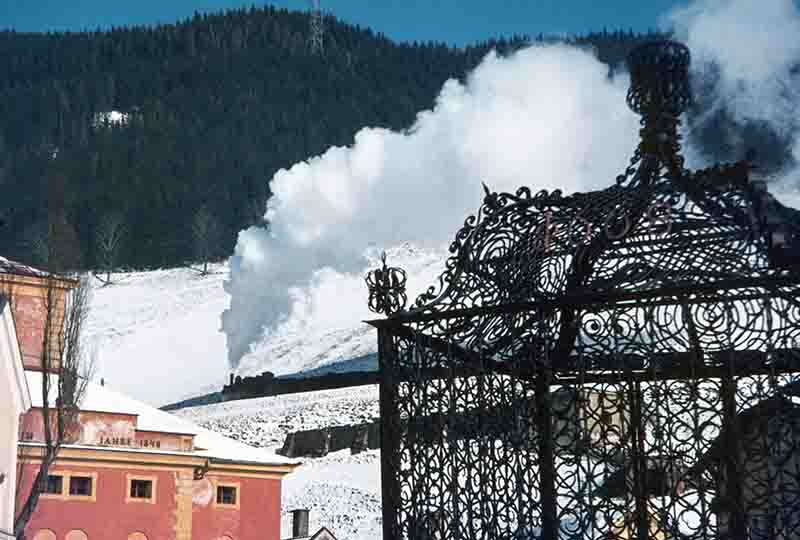
A pair of class 97 0-6-2 rack tanks, with number 97.207 leading, lift their train of ore empties for the quarries at Erzberg away from Vordernberg Markt on 10/02/1974.
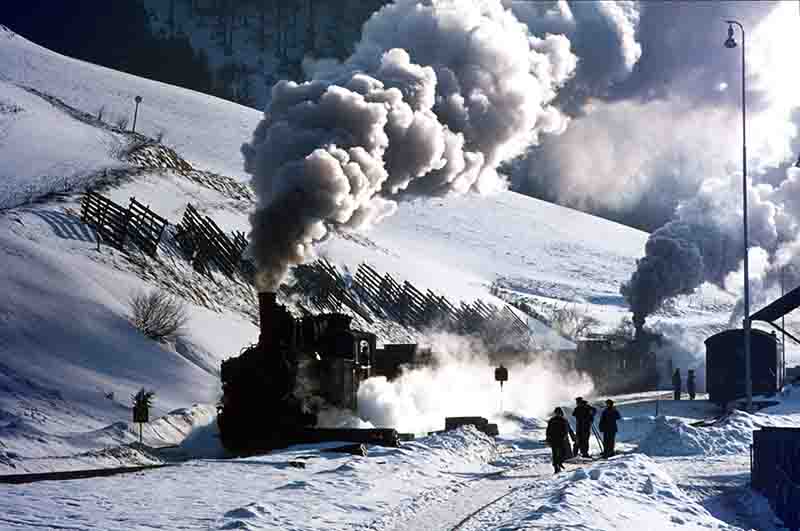
A pair of class 97 0-6-2 rack tanks working a train of ore empties stand in the station at Vordernberg Marktt on 11/02/1974.
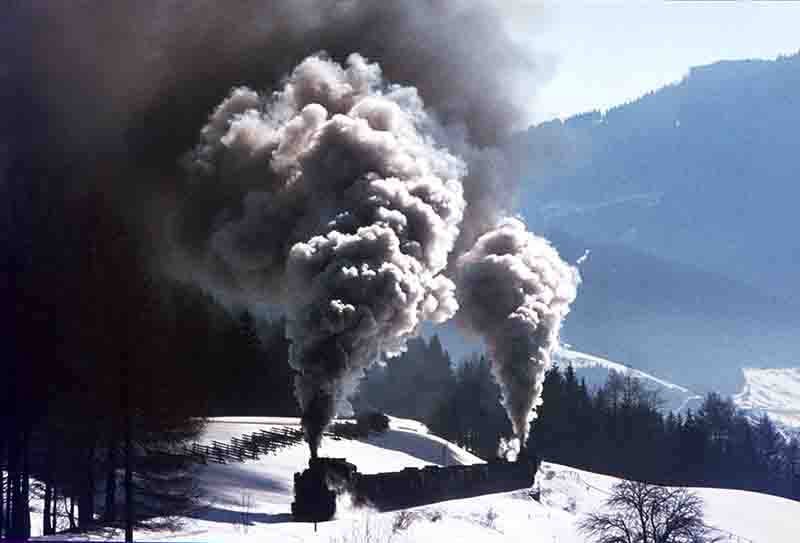
A pair of class 97 0-6-2 rack tanks working a train of ore empties head away from the water stop Glaslbremse and continue up the climb to the summit at Prabichl on 12/02/1974.
My final trip abroad with Mike was in 1979, when in the company of Dave Gouldthorp, we spent a fortnight in South Africa visiting eastern and central Cape Province; and the Bethlehem to Bloemfontein line in the Orange Free State on the 3ft 6" gauge lines.
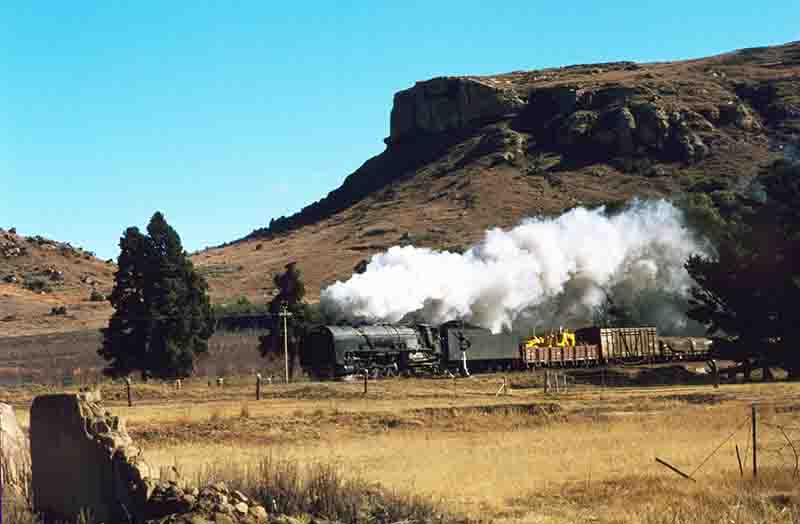
A South African Railways class 25NC 4-8-4 heads a southbound freight near Retiefsnek at the top of the climb away from Bethlehem on 23/07/1979.
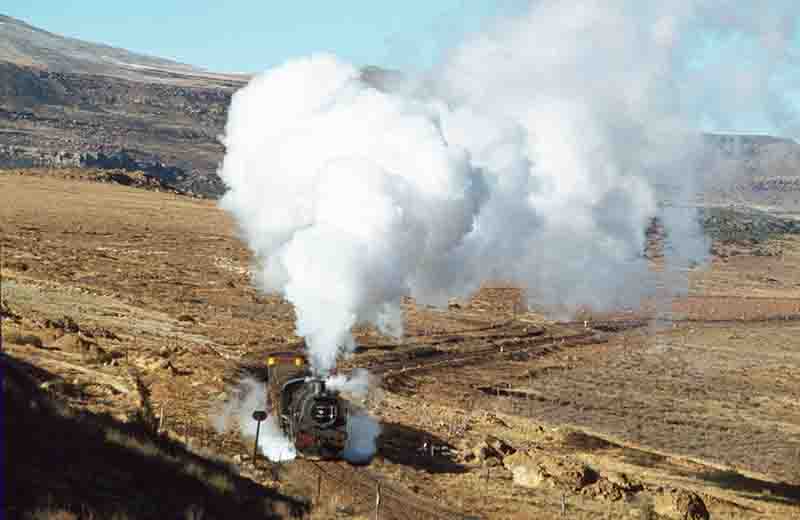
Class 19D 4-8-2 number 2712, built by Borsig in 1939, heads a freight from Sterkstroom approaching the summit at Withoogte on the 174 mile long Maclear branch in Eastern Cape on 25/07/1979.
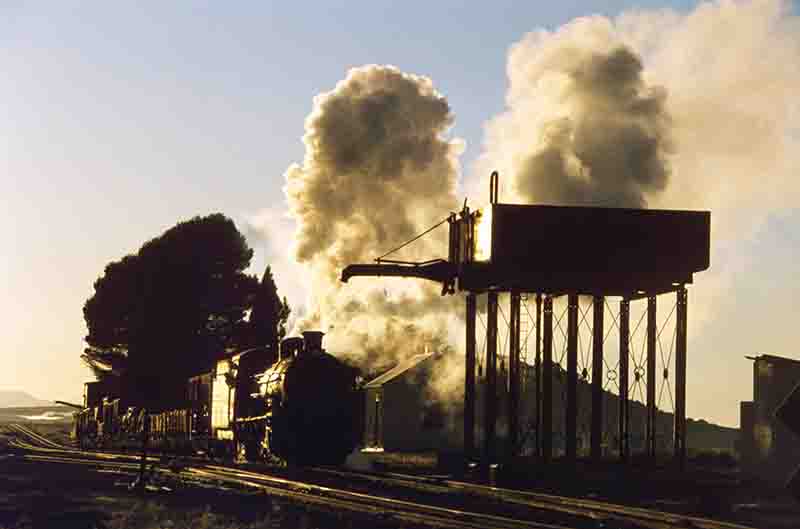
Class 15AR 4-8-2 number 1818, built by North British in 1920, departs Schoombie with a Rosmead bound freight on the link line between the Cape Eastern and Cape Midland main lines on 29/07/1979.

